Wednesday December 27, 2006
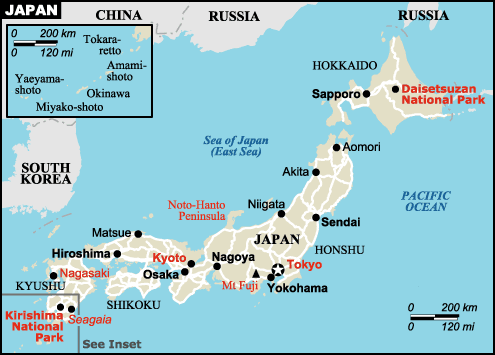
This trip to Japan sort of snuck up on us. Between having hardwood floors installed, buying new living room furniture, painting and redecorating the guest room, getting ready for Christmas, and entertaining my Dad, suddenly it was the day after Christmas and we were packing for Tokyo.
The 4 am alarm was an unwelcome sound, but our trip to the airport and flight to Atlanta were uneventful. By 10 am we were boarding Delta flight 55 for the 14-hour flight to Tokyo’s Narita Airport.
The Boeing 777 was a lovely plane, with business elite seats that nearly reclined flat. I exchanged 360,000 frequent flyer miles for the tickets back in March, when I thought Delta might be going out of business. Even though they are still in bankruptcy, it was gratifying to see that their international service has really improved — a necessity to compete with foreign carriers on their many new routes. As a result, the food and service was excellent. The Japanese meal I had was particularly noteworthy, with a dozen small ceramic dishes of tasty mysteries.
We were able to nap for several hours, which helped make up for the early morning and ten time-zone shift (Tokyo is 14 hours ahead of Orlando). Dani took advantage of my new laptop’s 9-hour battery to add 3500 words to her novel, The Last Telepath, which is now past 20,000 words.
The flight path took us over Alaska — I know, it doesn’t seem like a shortcut until you look at a globe. We arrived a bit after 2 pm Thursday, having lost an entire day somewhere over the Bering Sea, when we crossed the International Date Line.
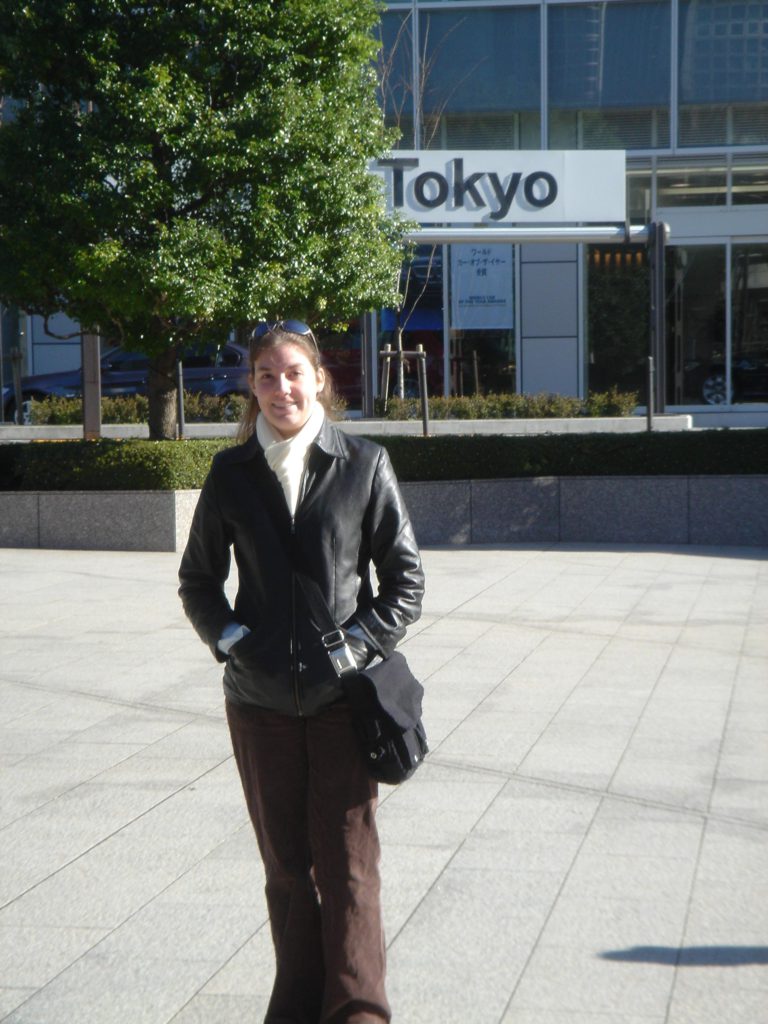
It was very windy in Tokyo, which made for an exciting landing. I was struck by how much the airport — and much of the city’s architecture, for that matter — looked like Frankfurt. In fact, all of Tokyo looks much more European than I was expecting. Except for the signs in Japanese, the sea of 5-foot tall, black-haired people, and the cars being on the opposite side of the street, it would be hard to distinguish it from any major European city.
The people are very different, though. Friendly but reserved, and extremely focused on doing things right. This was in evidence from the moment we arrived at the airport. Waiting for the bus to the hotel, industrious porters arranged and tagged our luggage and positioned it (and us) just so, in anticipation for the spot-on arrival of the bus. There was much more spoken English and English signage than I was expecting, although this changes dramatically, away from tourist-frequented areas. In the city there are lots of English names on stores and buildings, but they’re mostly just words that sound good to the Japanese, and don’t convey any meaning.
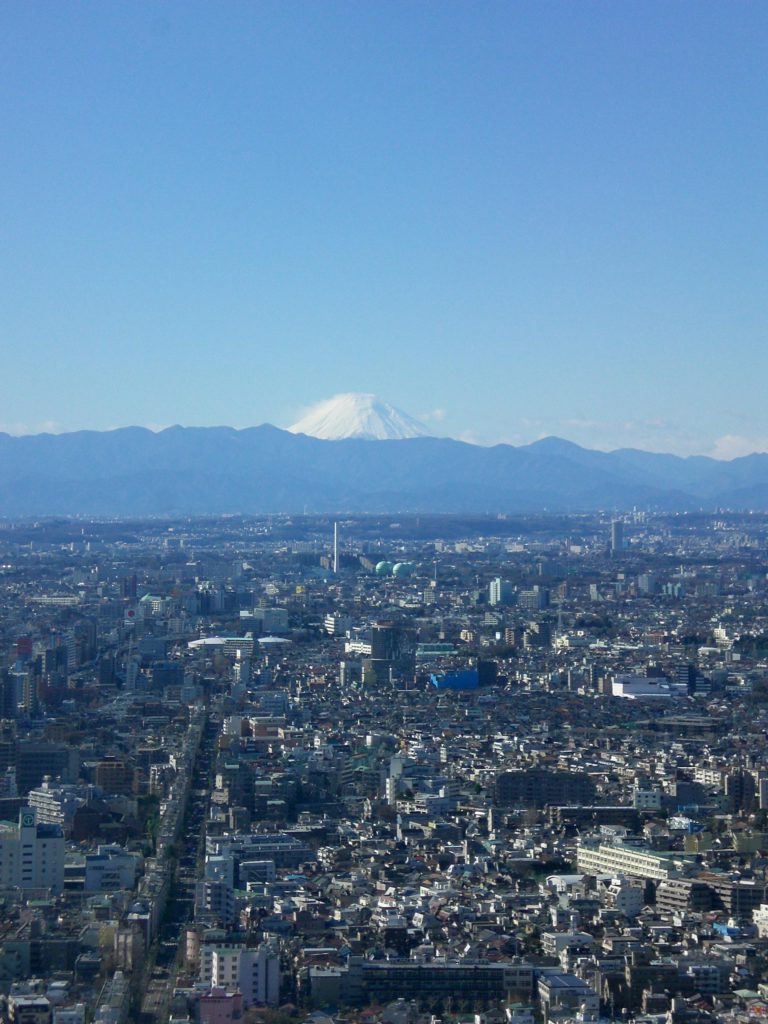
The topography of Japan is similar to Southern California, although one guide book described it as looking like a perpetual construction site. Certainly the land is thoroughly used, with every acre of the 45-mile drive from airport to hotel occupied by either a rice field or a building. Speaking of guidebooks, here are some things I learned by reading the excellent Time Out Tokyo during the flight:
Japan is an archipelago that stretches from the latitude of Miami to Montreal. Tokyo is about even with Atlanta.
The Japanese literacy rate is 99%.
There is no tipping in Japan, an odd but refreshing experience.
All but three of Japan’s 3000 streams and rivers are dammed!
Approximately 100 million Japanese practice the traditional Shinto religion. And 100 million practice a version of China’s Buddhism. Impressive, considering the population is 127 million. Clearly these people are hedging their bets.
On the drive from the airport we passed a Carre Four (French) supermarket, Tokyo Disneyland, a very, very large Ferris wheel, The Ginza shopping district, and Tokyo station. By this time the sun had set (at 4:30!), and the city was a mixture of Vegas neon and brightly lit office buildings. Workers were still hard at it in most of the buildings, but there were also a lot of office parties in progress. December 28th is the last day of work for most people, and culminates in a traditional Japanese-style blow out. Many of these workers won’t go back to their jobs until January 4th.
Central Tokyo was a literal tangle of streets, bridges, causeways and canals. It was amazing to see vending machines glowing in the darkest corners of these concrete mazes. In a city with low crime, these machines are safe from vandalism everywhere. And they are everywhere, vending, soft drinks, beer, cigarettes, condoms and even used teenage girl’s panties (although we didn’t actually see any of those. . . sorry, Dave).
At the hotel I was bemused that, in a city with little crime, procedure still dictated that every last baggage tag be matched to our luggage as we disembarked. This was all done for us, but it had to be done.
I didn’t realize it when I booked it, but we’re staying at the hotel where Lost In Translation was filmed. The Park Hyatt is a stylish, modern facility occupying the 41st through 51st floors of one of the western-most high rises in Shinjuku, Tokyo’s “skyscraper” district. At over 300 square feet, the rooms are among the city’s largest. The staff is extremely efficient (of course) and friendly, and well-versed in English. A measure of their efficiency was that when we checked in they didn’t have a record of the third person in our room. By the time we were escorted to the room, there were already three people there making it up for the extra person.
Our luggage was delivered moments later by a young lady who apologized profusely when I had to help her heft the largest piece onto a shelf to prevent her from being flattened — but better to lose face than life.
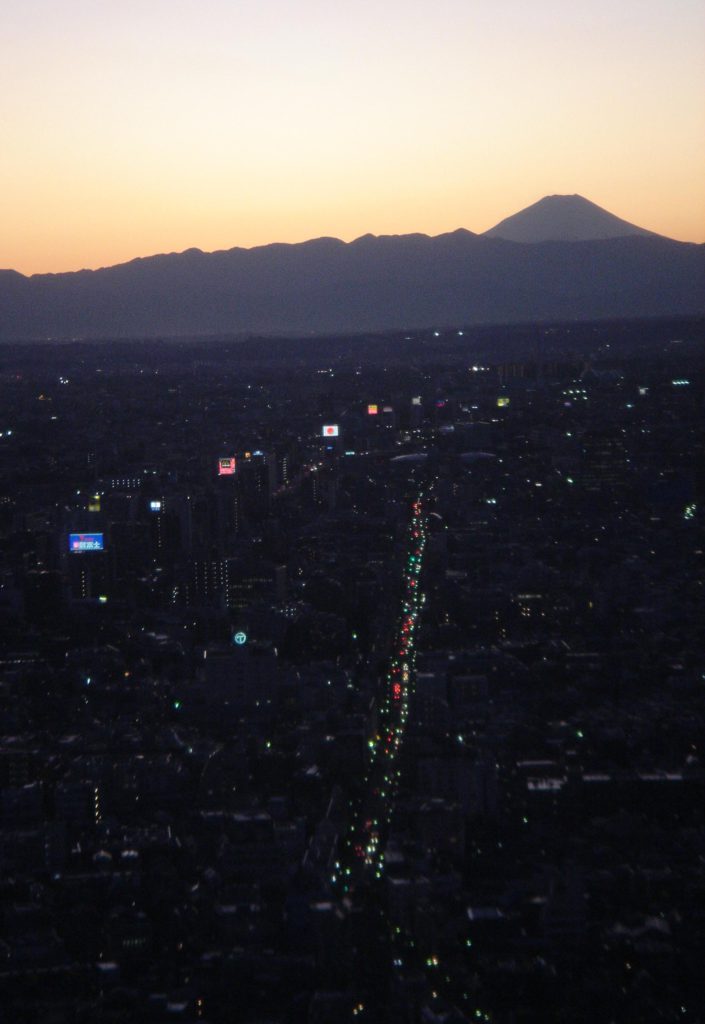
The wind had swept away the clouds, providing infinite visibility in all directions. Given how even the locals lingered at the windows, I suspect this is a one-a-year event. As promised, our room looked directly onto Mt. Fuji. I wonder how many guests have never spotted it?We had an early dinner in the lobby restaurant, Girandole, which specializes in American food. It was okay, but expensive, more attributable to the hotel it’s in than the cost of Tokyo these days, which after fifteen years of inflation isn’t nearly as high as it once was. The exchange rate is pretty good — 118 Yen to the dollar — but this is still going to be an expensive trip: a bottle of San Pellegrino water is $15. By 7:30 pm we were in bed, and didn’t surface until 7 am.
Friday, December 29, 2006
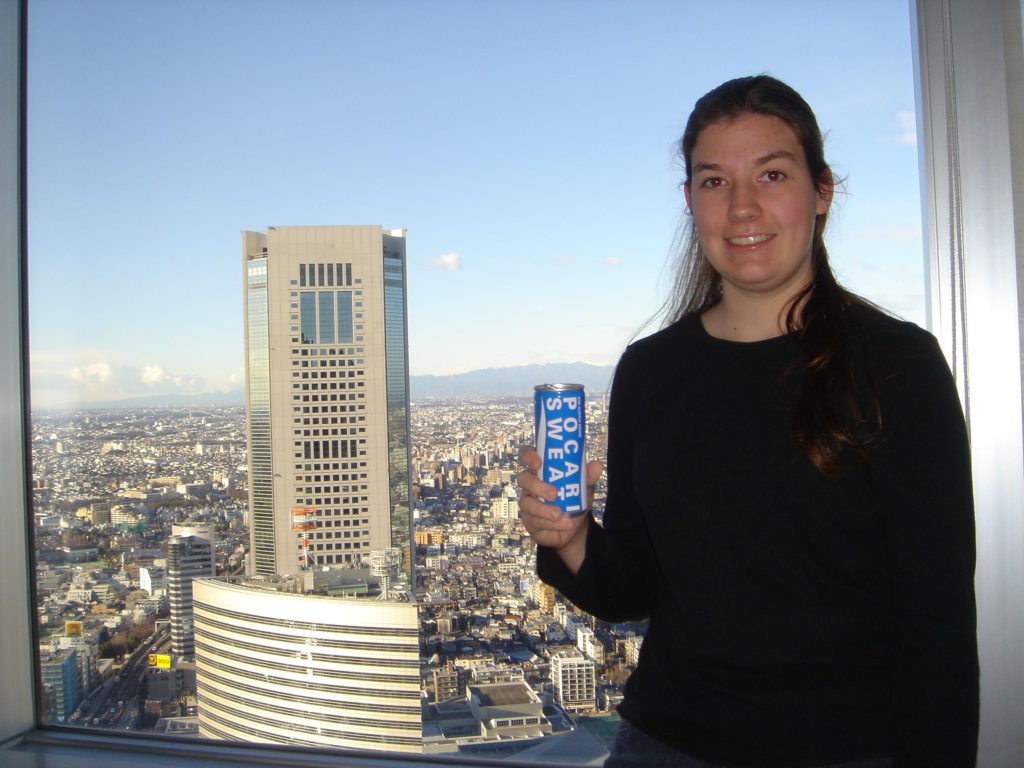
The next morning we awoke to find Tokyo dazzling. Still breezy, and with few commuters to replenish the smog, visibility remained infinite. Dani and I had an American breakfast in the lobby restaurant, with delicious croissants, scones and other pastries.
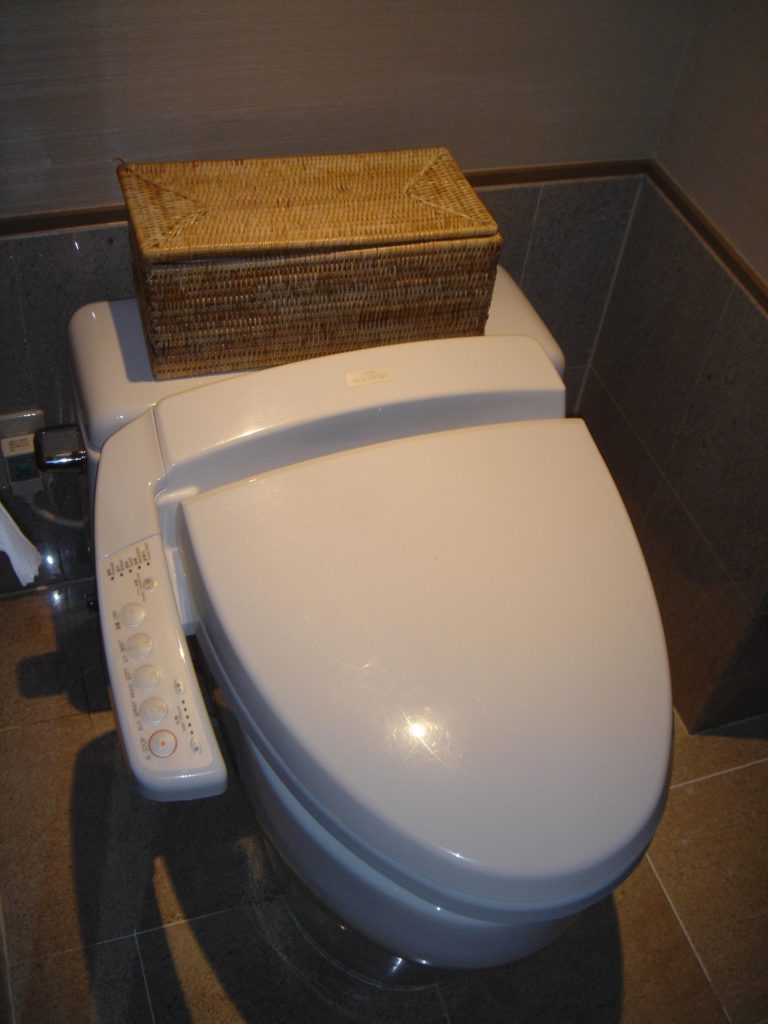
The most notable feature of the room is one the Japanese take for granted. No, this isn’t the captain’s chair on the bridge of the Starship Enterprise, although it has more buttons. Don’t press them unless you like surprises. It’s typical of most toilets in quality establishments in Japan. Because the Japanese don’t like rude noises, it is also the habit of women to flush the toilet multiple times to mask the sound. Because this was wasting water, many public toilets are equipped with audio players that make a flushing noise when their button is pushed!
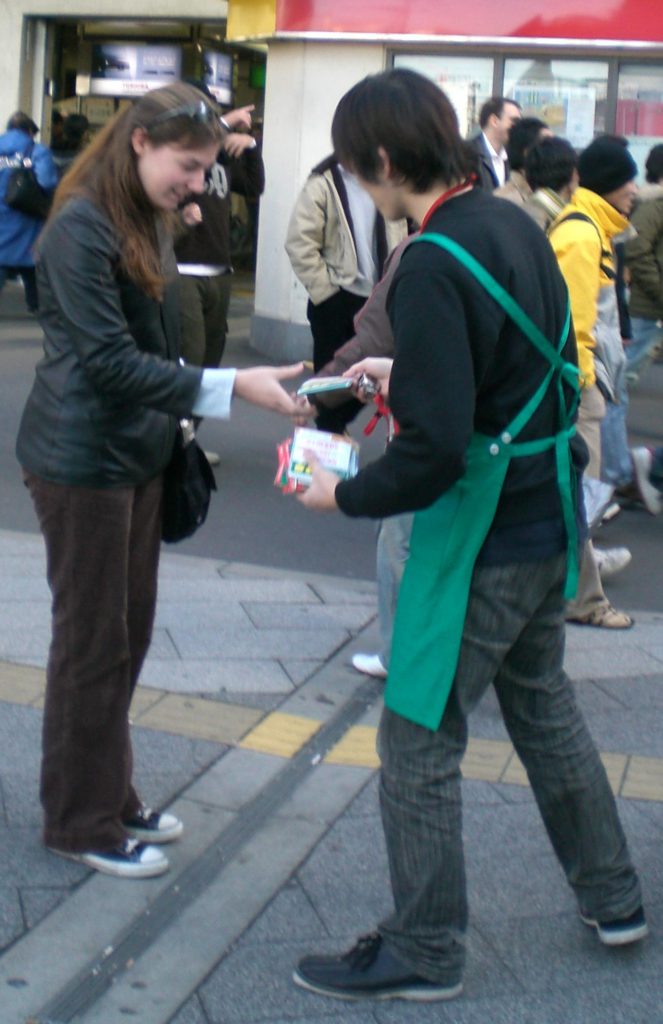
There is an entirely different type of public toilet that provides a far less pleasant experience. As you walk around Tokyo, you are often handed packets with advertising on them. The advertisers know you won’t throw them away, because they contain toilet paper — a necessity in this other caliber of public facility.
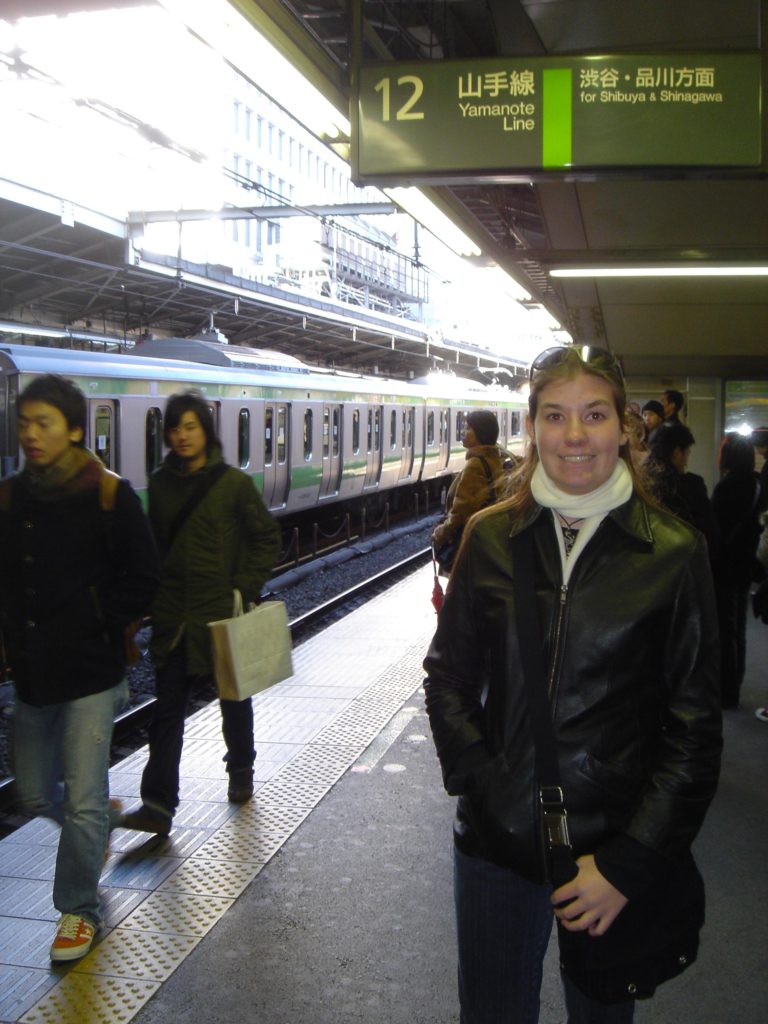
After a visit with the concierge, Crystal Wong, to organize our week, we set out to explore. A twenty-minute walk East brought us to Shinjuku Station. Thanks to careful reading of the guide and a few leaps of logic, we were able to use the automated kiosk to purchase three Suica passes, essentially wireless smart cards with pre-loaded fares. These will work on the Japan Railway trains, but not on the other three competing systems. Shinjuku Station is the one that often appears in films of rush hour in Tokyo: white-gloved personnel pressing commuters into trains so the doors will close. Fortunately for us, the New Year holiday means the trains are almost empty by Tokyo standards, with only a few people in each car. The Yamanote line is a particularly easy way to get around Tokyo, as it makes a loop, and stops in most of the places that interest visitors.
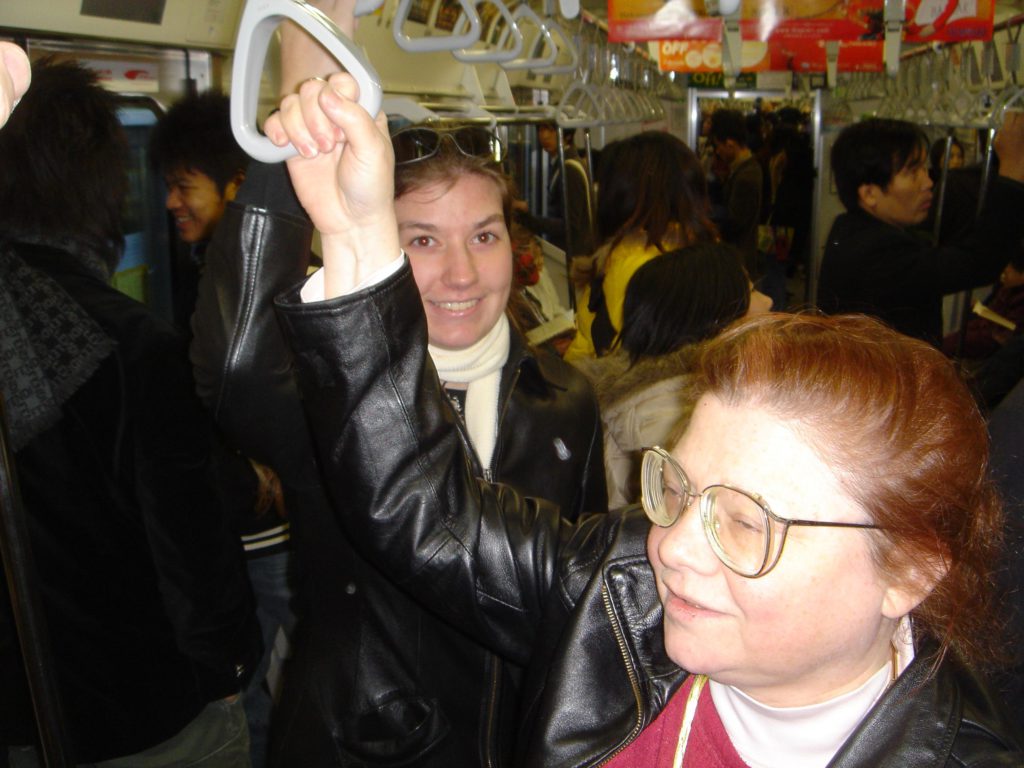
Most Tokyo streets aren’t named, which makes it a bit of a challenge to get around. Navigating the rail system is quite easy, once you get the hang of it, because routes — and the corresponding trains — are colored. Stops are named, but not always in English. Recognizing the Japanese characters is very difficult, but you can get off by counting stops. And the trains are so timely you can also tell where you are by how long the ride has been.
But once you come out of the station, you have to navigate by the names of buildings or businesses. Addresses are a combination of the ward, district, chome, block and building, sometimes named, but mostly numbered arbitrarily. This means maps are of only limited use. But if you stand staring at a map, looking lost, someone will probably offer assistance. Of course, they may then have to ask a policeman!
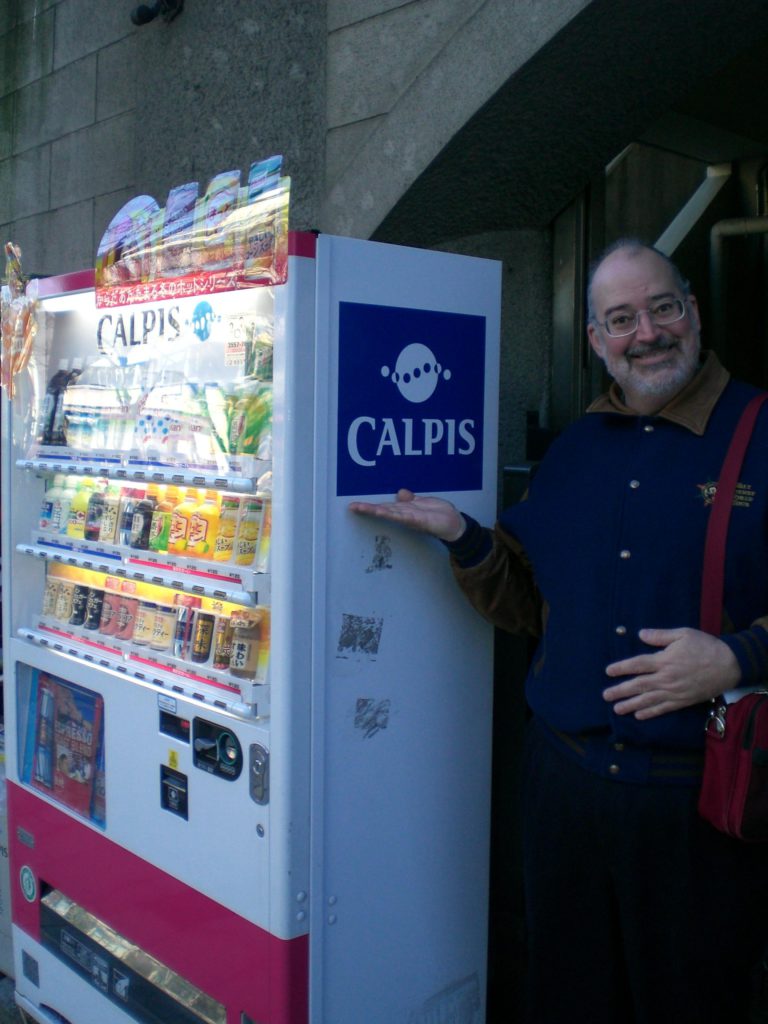
Two stops to the South brought us to Harajuku, an upscale shopping and restaurant district. We strolled up and down the street looking for a Japanese restaurant with English menus, finally settling — by mistake — for one that turned out to be Chinese. It was a nine-course affair of mostly unfamiliar stuff. I can’t say I found anything spectacularly wonderful, but there were a few tasty things.
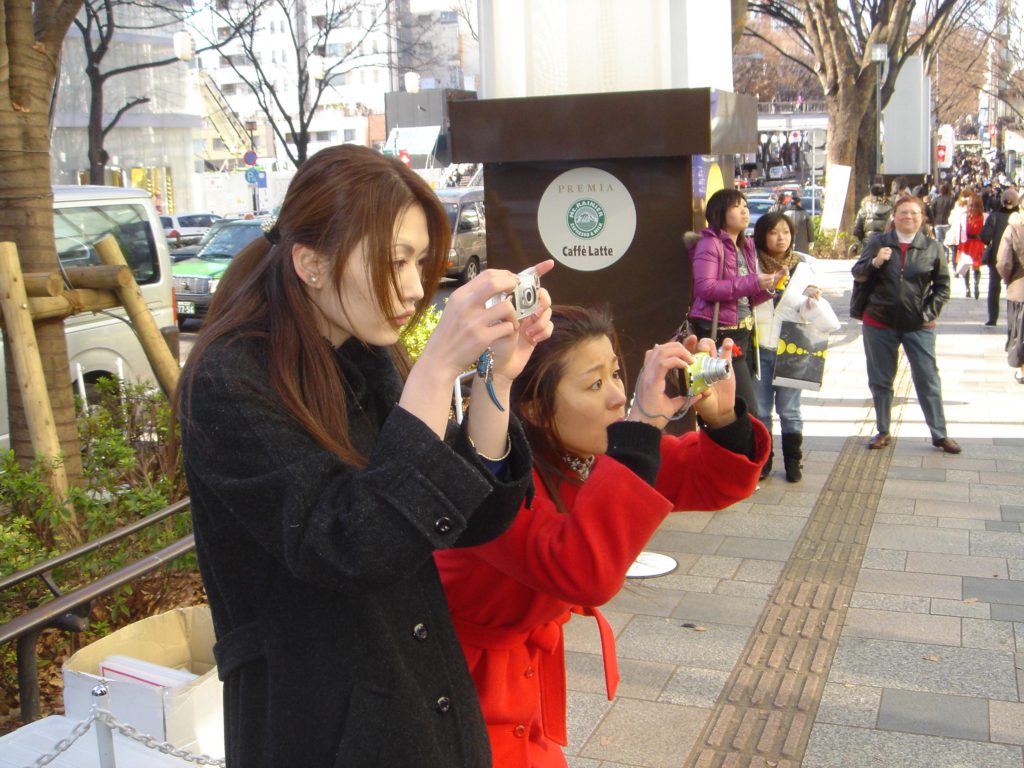
One thing about Tokyo — you never have to feel self-conscious about taking pictures. Everywhere people were snapping photos and taking videos. We saw very few foreigners, but there were either a lot of Japanese tourists, or they just like to document everything.
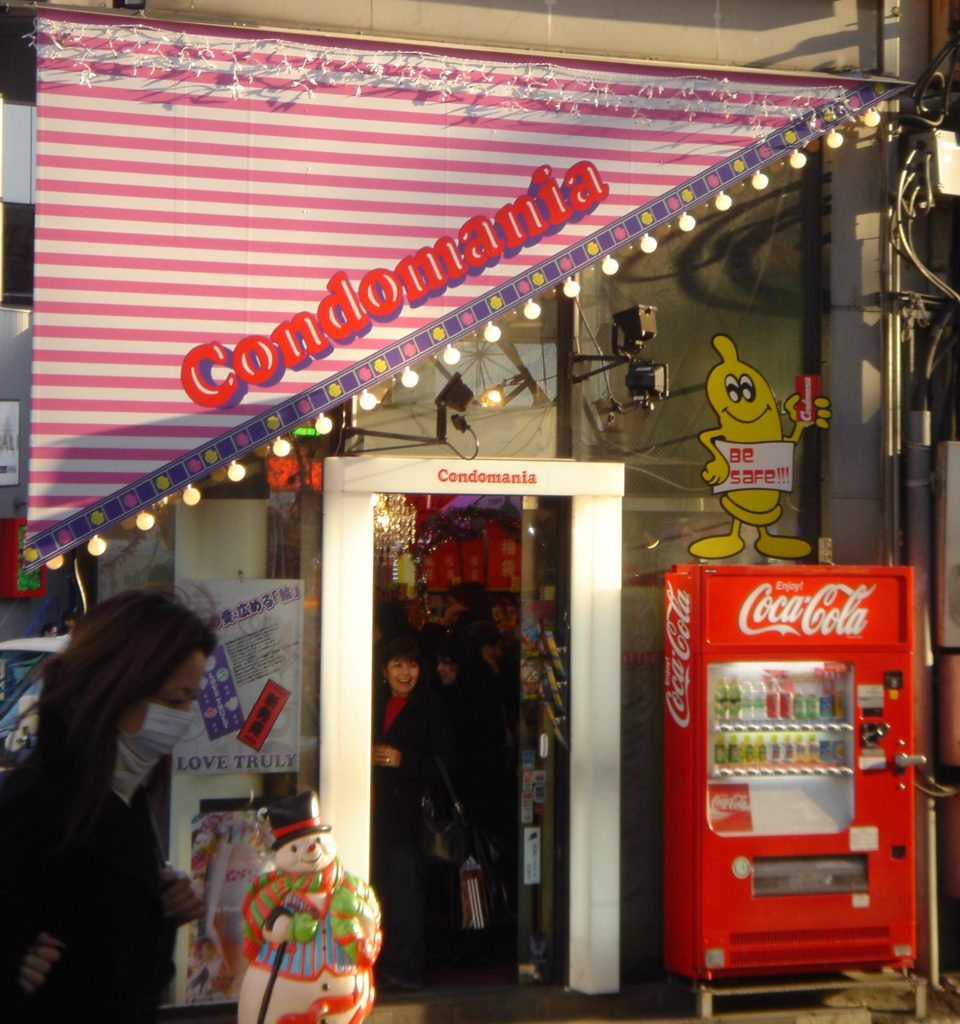
We visited a store called Kiddy Land (you can’t count on the name implying the contents in Japan) that specialized in animated gizmos (including radishes) and radio-controlled gizmos, and kitsch. After exploring one floor we discovered there were five more and gave up.
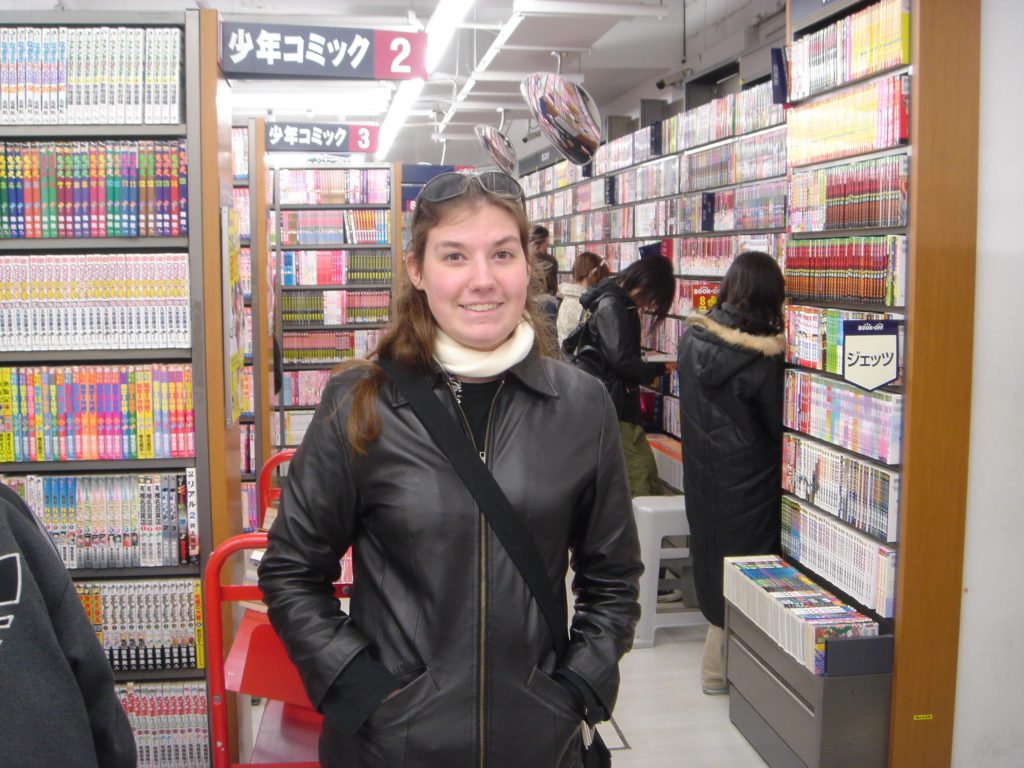
Dani discovered an enormous Manga (comic book) store. 40% of Japanese publishing is Manga, and there are titles that appeal to boys, girls, men and women. When translated they cost about $10 a book in the US, but many are under $2 in Japan. How frustrating: 10,000 titles, and not one in English!
We later learned the Japanese write two different ways. The traditional vertical technique is read top to bottom, left to right. But young people prefer to read left to right, horizontally, and many books are now being published this way. This is also how text messaging on the phones work. (Text messaging is quite popular here, because voice calls may not be made on public transportation, as it annoys fellow travelers. ) How you text message in Japanese using a ten-key pad is beyond me, though.
The nearby Takeshita Dori specializes in shops for teenagers (sample name: Goth and Lolita). More on this later.
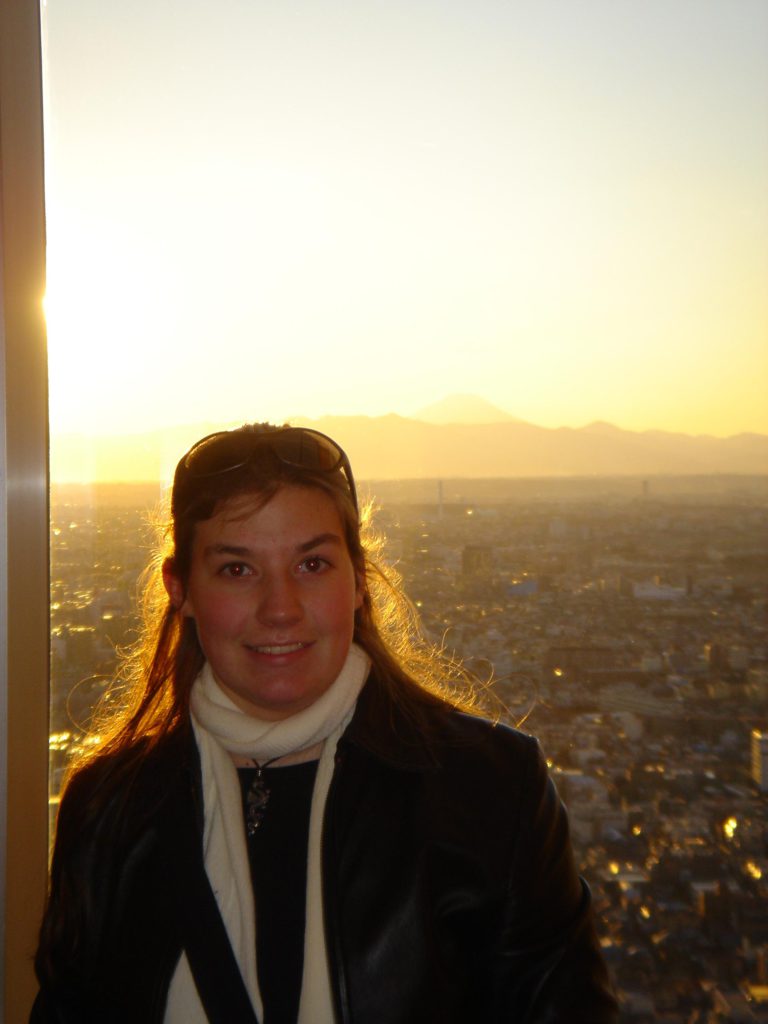
The high today was in the 40s, and it continued to be breezy, so as the sun set we retraced our route to Shinjuku station — spending only about half an hour reorienting ourselves as we re-emerged through a randomly selected exit. Back at the hotel our heated toilet seat actually felt good.
We had a nap and then a late (9 pm) dinner in the hotel’s Japanese restaurant, Kozue. This is a fairly famous restaurant, where each dish is a unique ceramic work of art. There were eight courses, some of which contained many individual items themselves. Many dishes were based upon broth, and there were many new flavors. In the end, it was the sashimi that I liked best, by a wide margin. Not coincidentally, it was the only thing that seemed familiar. Dani has been quite adventurous food-wise, but I think she found today’s lunch and dinner a bit challenging. I know I did. Linda, following the philosophy “when in Rome do as the Phoenicians do,” tried some Japanese white and red wines. They reminded me of the Florida wines Blanc du Bois and Noble. On the whole I thought the meal was just okay. I stayed up late, catching up on my journal.
Saturday, January 30, 2006
Continued cool and clear, although not quite the dazzling clear of yesterday. After some nice pastries in the lobby we set out for Akihabara. This involves taking the Yamanote line halfway around its circuit of Central Tokyo, a thirty-minute trip.
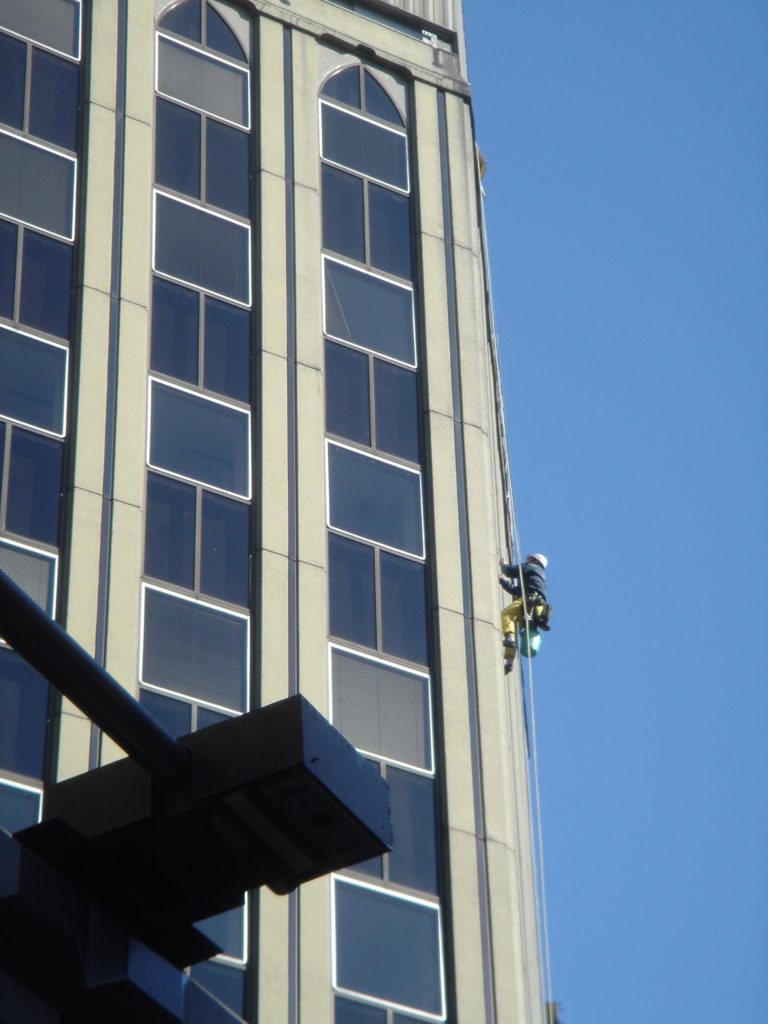
On the walk to the station I saw someone washing highrise windows. This is done by essentially rappelling down the side of the building. As dangerous as it looked, it was topped later by a guy clinging to a ledge washing the windows outside his restaurant.
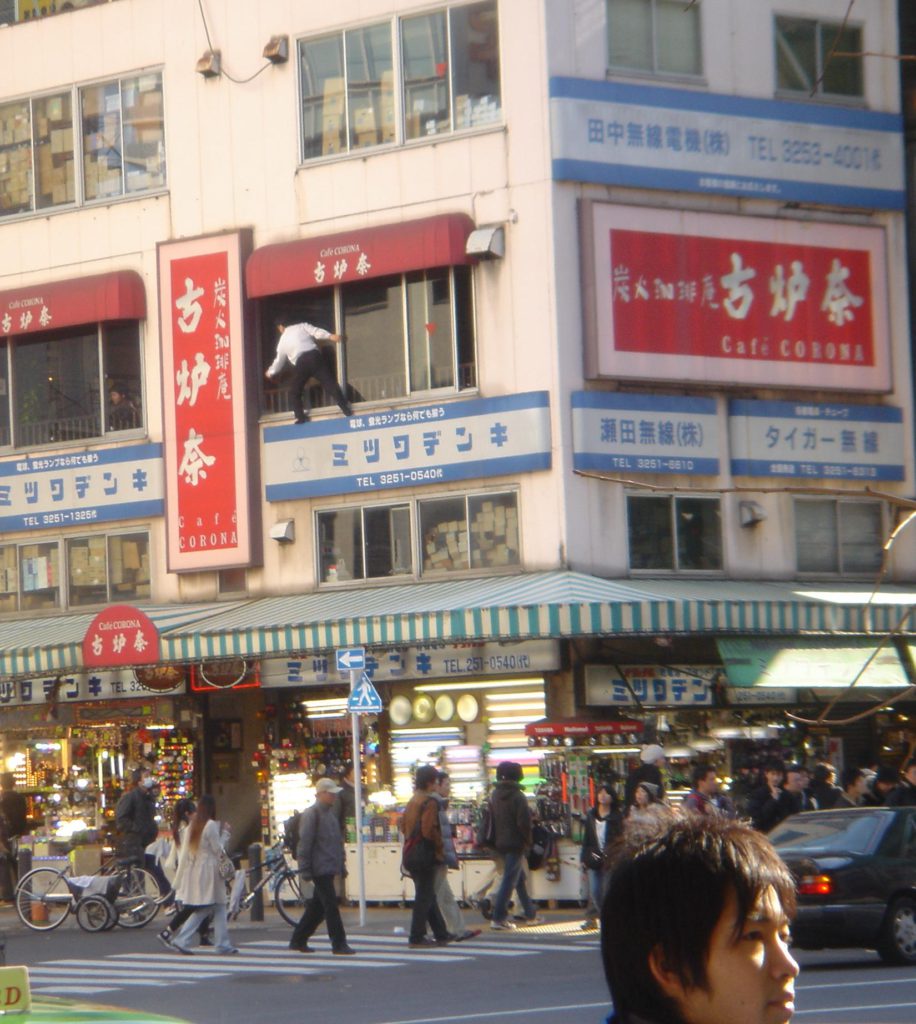
Akihabara is Tokyo’s “Electric Town. ” It started as a black market center for tubes and other electronics after World War II, and has since become the place to buy consumer electronics. There are over 600 booths, shops and stores crammed into a few blocks.
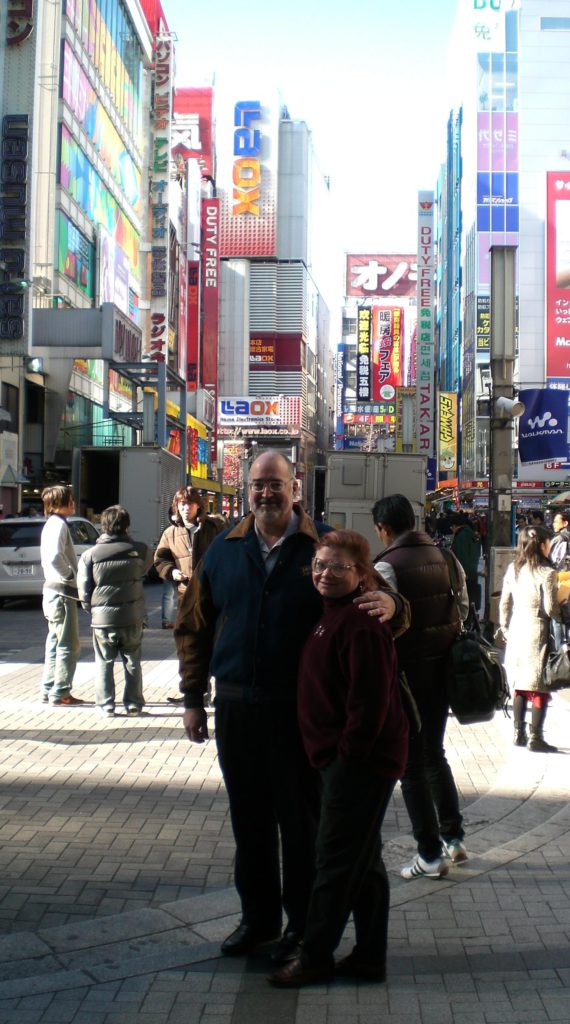
For me, the most interesting ones are the small booths right beneath the train station. Reminiscent of a permanent flea market, each specializes in one category of component, such as LEDs, transformers, or even screws. Unfortunately, this was the least interesting area to everyone else.
There were no deals on consumer electronics. The Japanese versions of some products were a bit cheaper than in the US, but the export versions (which have an international warranty and English menus) were the same price they would be for a savvy Internet shopper.
Dani bought some T-shirts and souvenirs at Llaox, a seven-story duty free electronics and gift shop. Duty free means the store carries export merchandise, and will refund your 5% tax on the spot if you spend more than 10,000 Yen (about $80).
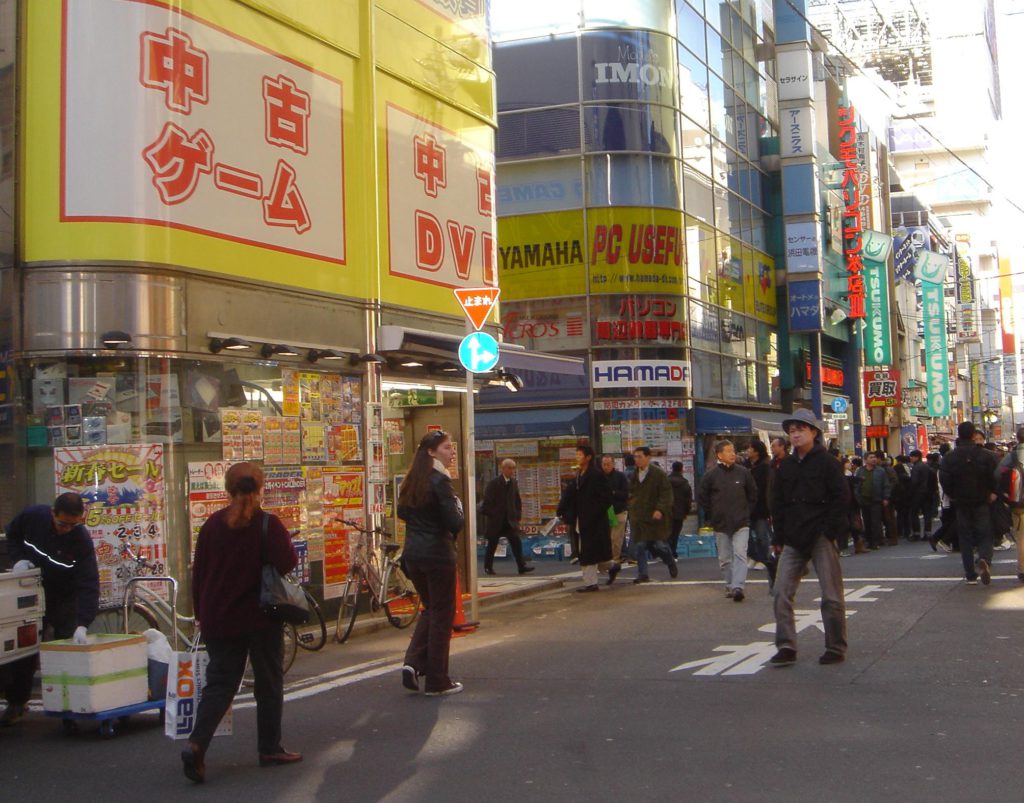
Because of its appeal to the young male otaku (nerds), Akihabara is also filled with Manga and Anime shops. The one we visited consisted of seven floors, each about 1000 square feet, with approximately 100 nerds per floor. Navigating the three-foot wide stairwells was interesting. The ground floor offered the most varied selection, with the other floors devoted almost exclusively to porn in all its variations, Lolitas and tentacles (or a combination) being the most popular. (There’s no stigma against reading porn in public here. The shelves of the am-pm mini mart are lined with it. )
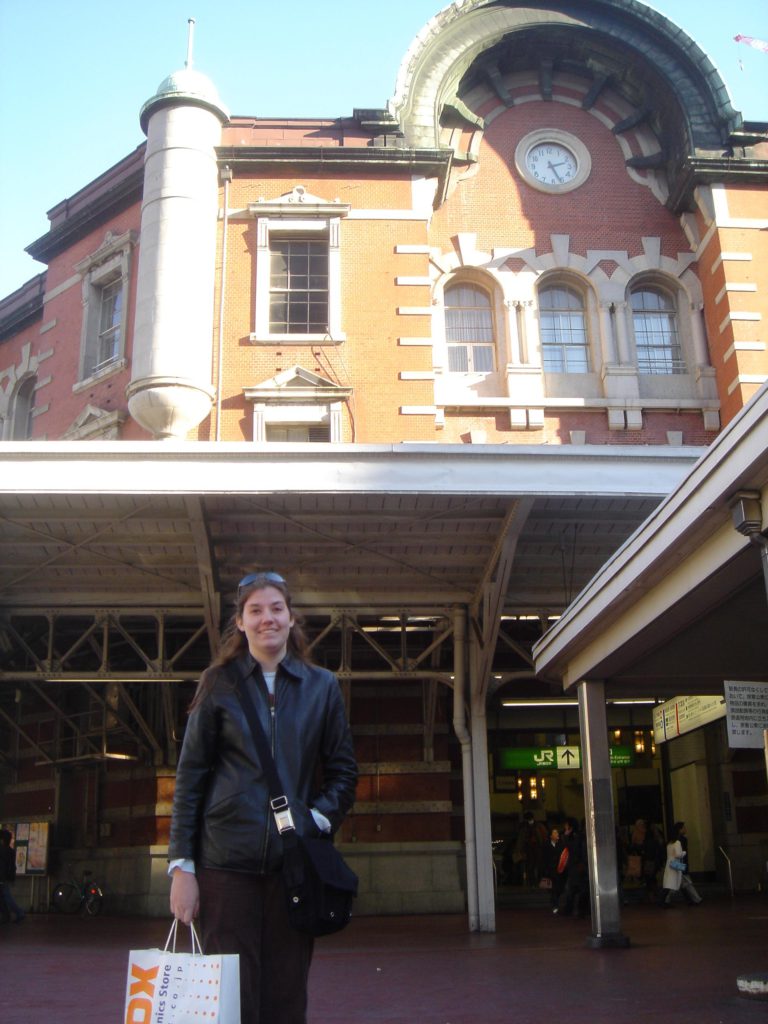
Having found no deals, no English Manga, and no appealing restaurant in Akihabara, we got back on the Yamanote line for two more stops and disembarked at Tokyo Station. Built to look like Amsterdam’s Centraal station, it is one of Tokyo’s oldest buildings, although it dates from only the late 1800s.
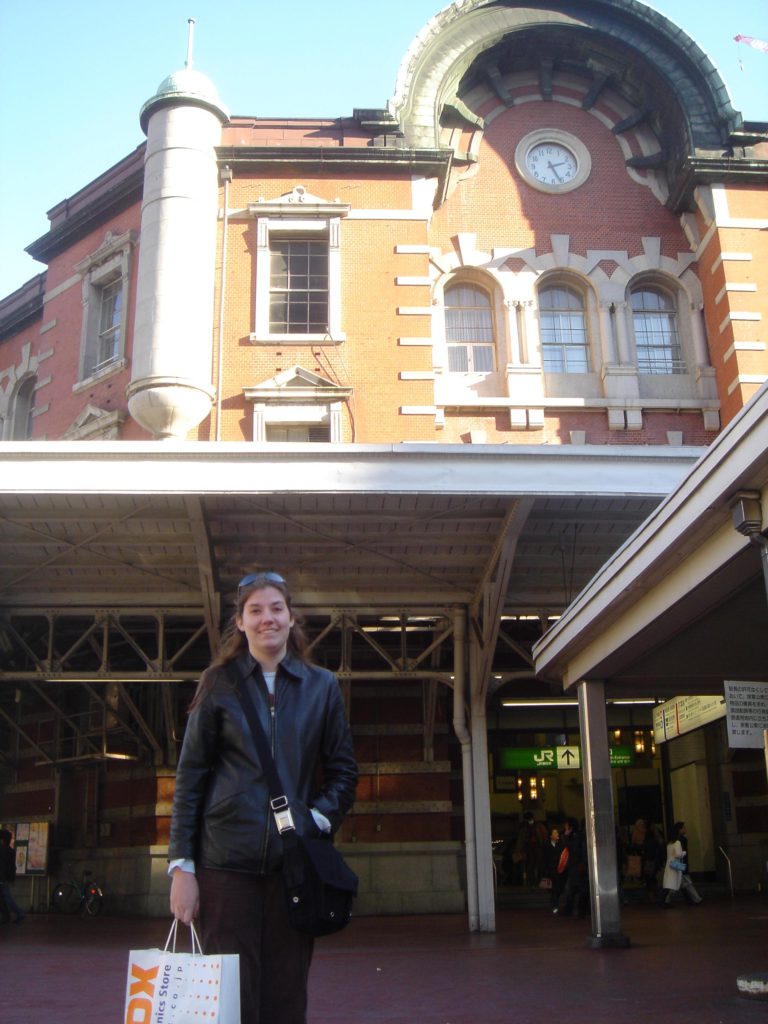
The station opens onto the Marunouchi district and beyond that the Imperial Palace. The Marunouchi Building is 36-story high rise with many floors of gourmet food shops and restaurants. In the lobby a large orchestra was playing classical music. It seemed odd that at the end of the pieces none of the spectators applauded.
We found a tempura restaurant on the sixth floor, and had a nice meal that involved a lot of pointing and nodding. Personally, I liked it better than last night’s extravaganza.
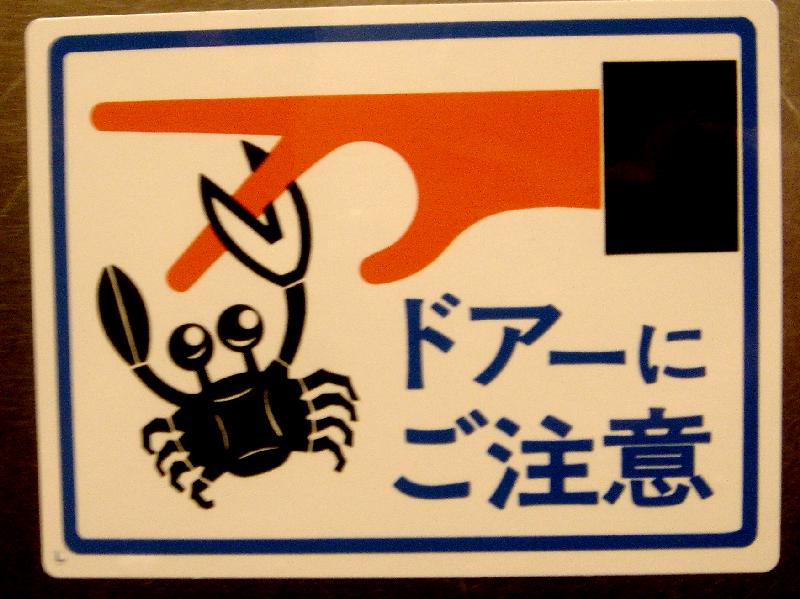
On the way back to the lobby, a sign in the elevator warned us not to put our fingers in the door.
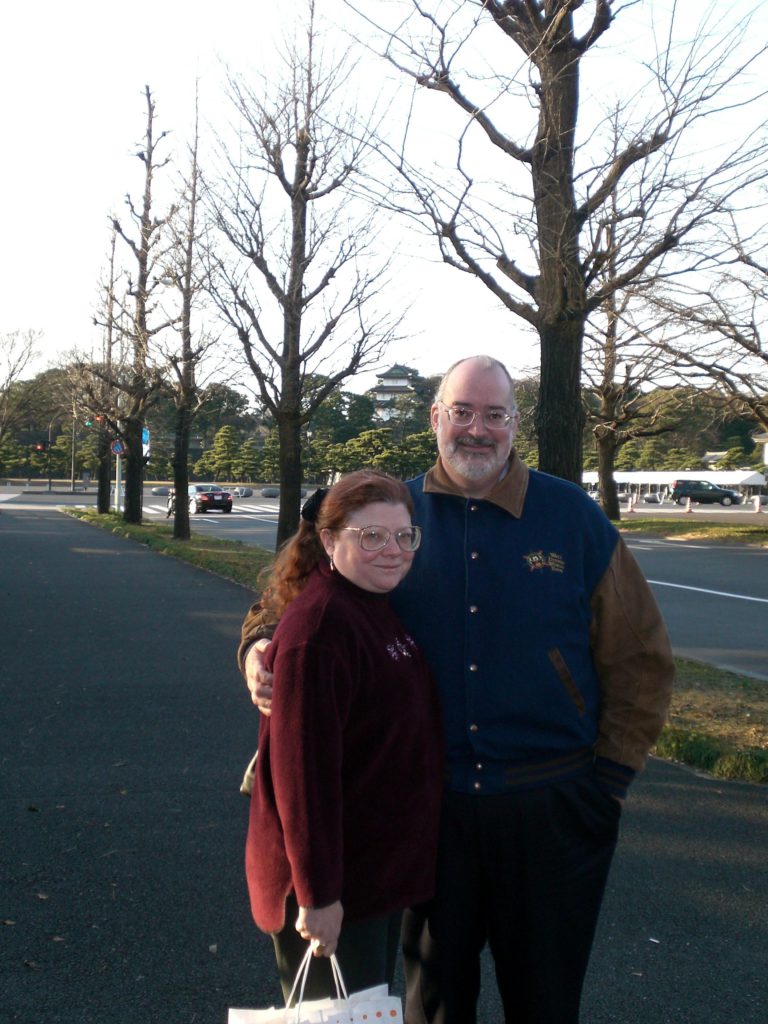
Two blocks north, we posed in front of the Imperial Palace grounds. They are open two days a year. Today wasn’t one of them.
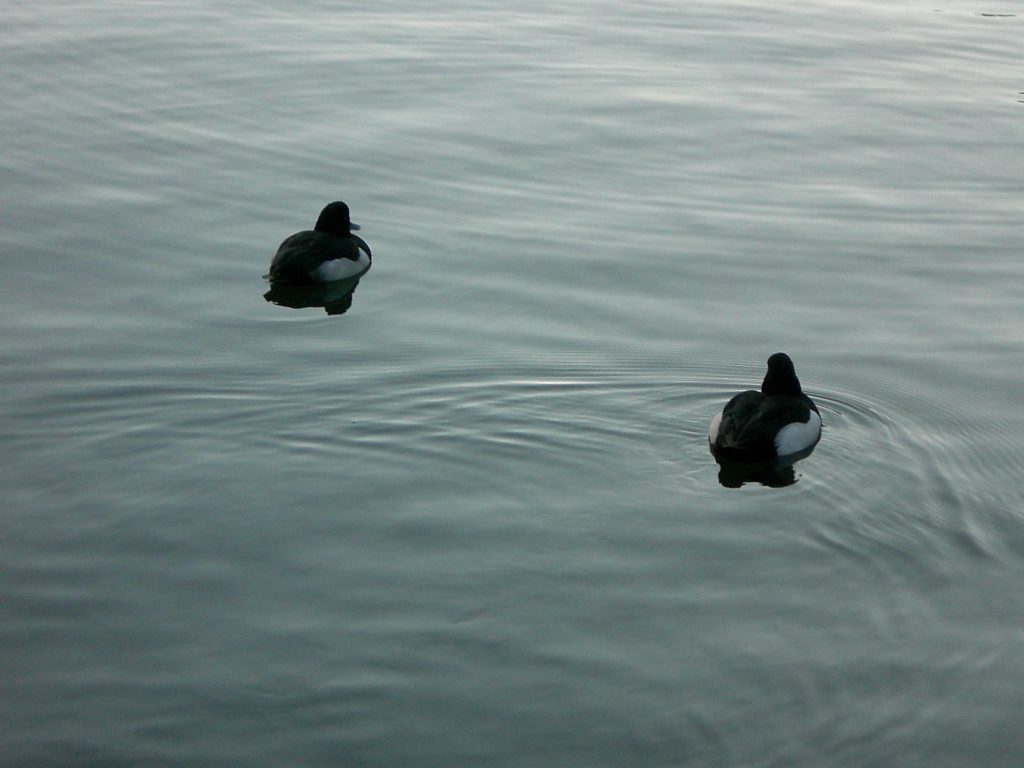
On the way back, Dani used the new camera Grandma Marjorie gave her for Christmas to take some art photos.
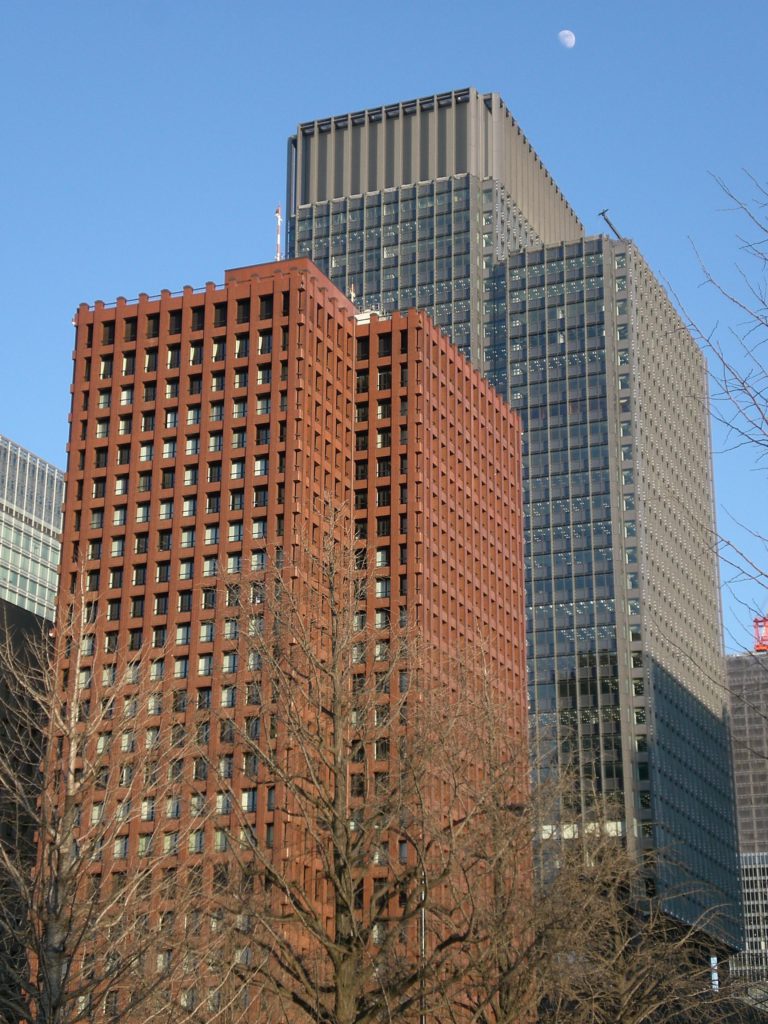
By the time we completed the circle of the Yamanote line it was approaching rush hour, but because of the holiday, traffic was light.
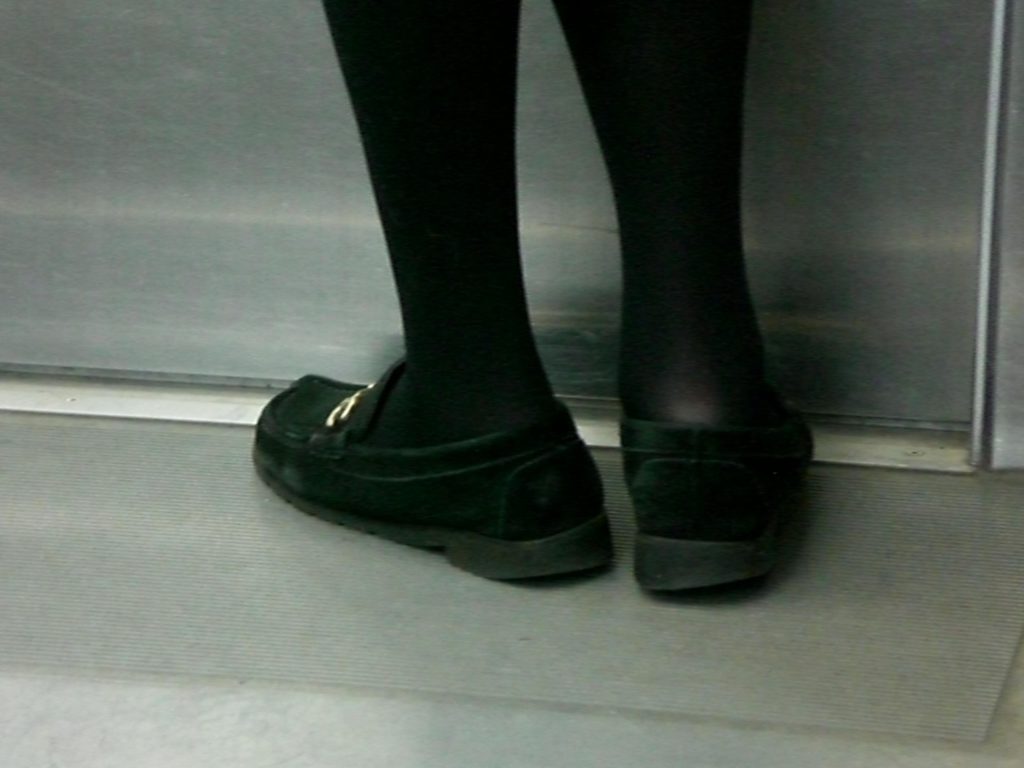
The walk back to the hotel after sunset was a bit cool, and we stopped at a mini mart for cans of coffee. I hadn’t realized that coffee was so popular here. It seems there is a coffee house on almost every block. So far they are holding their own against the encroaching Starbucks. After such a busy day and a late lunch, our 6pm nap turned into bedtime, and we didn’t venture out until the next morning.
Sunday, December 31, 2006
Another cool and fairly clear day, with highs in the 40s. Up a bit before sunrise, we watched Mt. Fuji change from purple to white in the morning light.

We had breakfast in the lobby. One thing on the buffet that I’ve never seen before is a complete honeycomb rack, removed from a bee hive. It drips into a collection tray, then runs into a serving dish.
Linda was feeling a bit under the weather, so she opted to relax in the room today. Dani and I decided to visit Roppongi Hills, a new shopping development in what used to be mostly the sleazy sex district. We took the subway, which is like a clean version of the London Underground. Like the train system, it’s easy to buy tickets and navigate, once you get the hang of it. And like the train system, the biggest problem is figuring out what exit to come out, when the streets have no names.
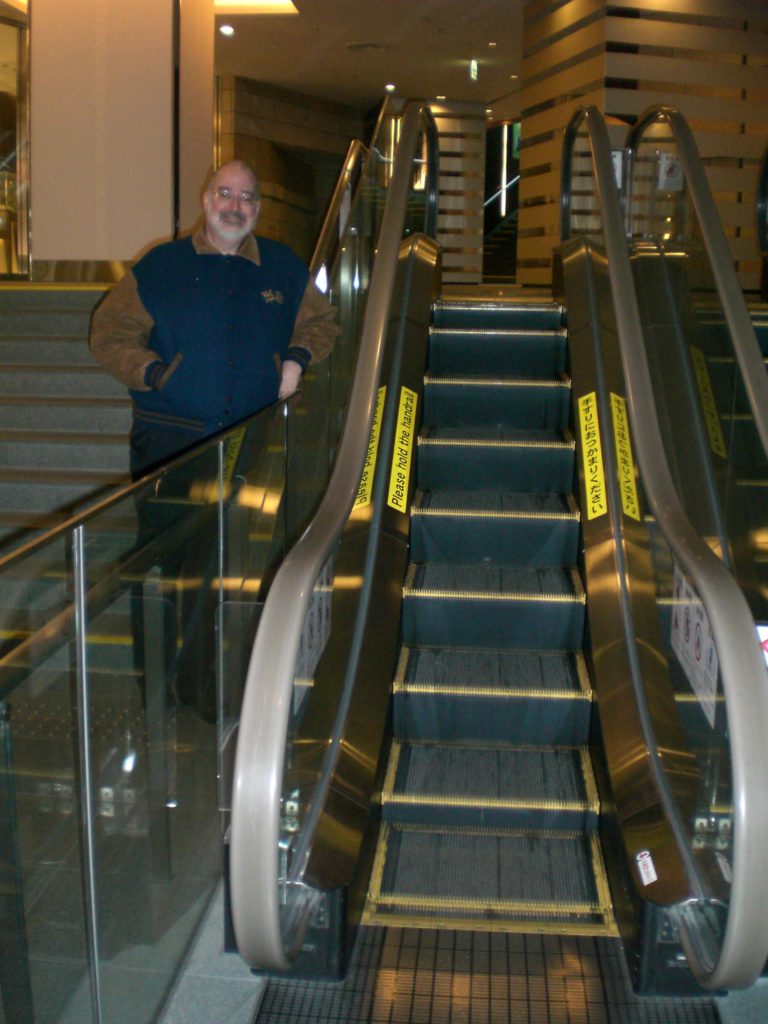
Roppongi Hills is a network of malls, on six levels. I have no idea how many stores there are, but the map is 12 pages long, and the separate restaurant guide is at least thirty pages. We spent a couple of hours wandering around, and Dani found a Japanese copy of Harry Potter and the Philosopher’s Stone. For someone who liked shopping, this place would be paradise.
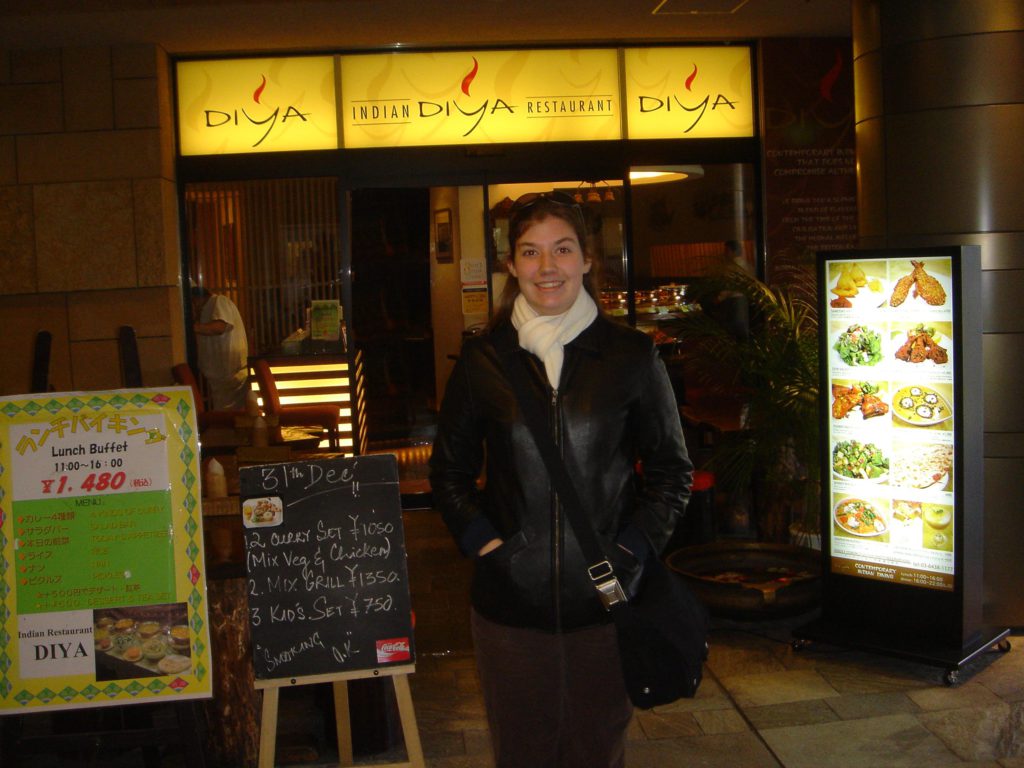
We selected an Indian restaurant named Diya for lunch, and had an excellent meal of curries and tandoori-grilled meats. No trouble communicating there.
After lunch we decided to return to Harajuku and Takeshita Dori’s funky teen neighborhood. We took the subway to the Yamanote train line; total travel time: 15 minutes including the connection. This transportation system works great. It sure was deserted most of the day, because of it being New Year’s Eve.
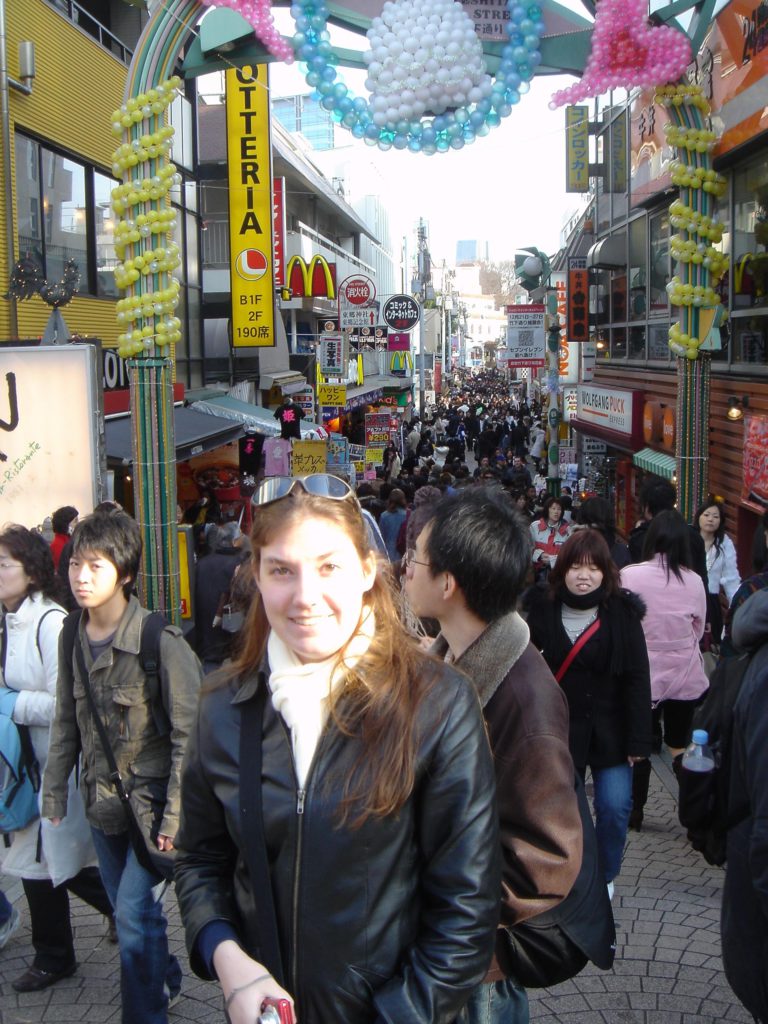
But Takeshita Dori wasn’t. The place was packed with teenagers, many dressed for cosu-purei or “costume play. ” 19th century French maids, lolitas, and leather abounded. There were an equal number of tourists checking out the funky shops. Dani bought some umbrellas with plastic animal handles. At the Manga store a helpful salesman directed her to the titles she was looking for, which were unrecognizable from the English editions. A whole bagful cost less than one book in the US. Too bad she can’t read them.
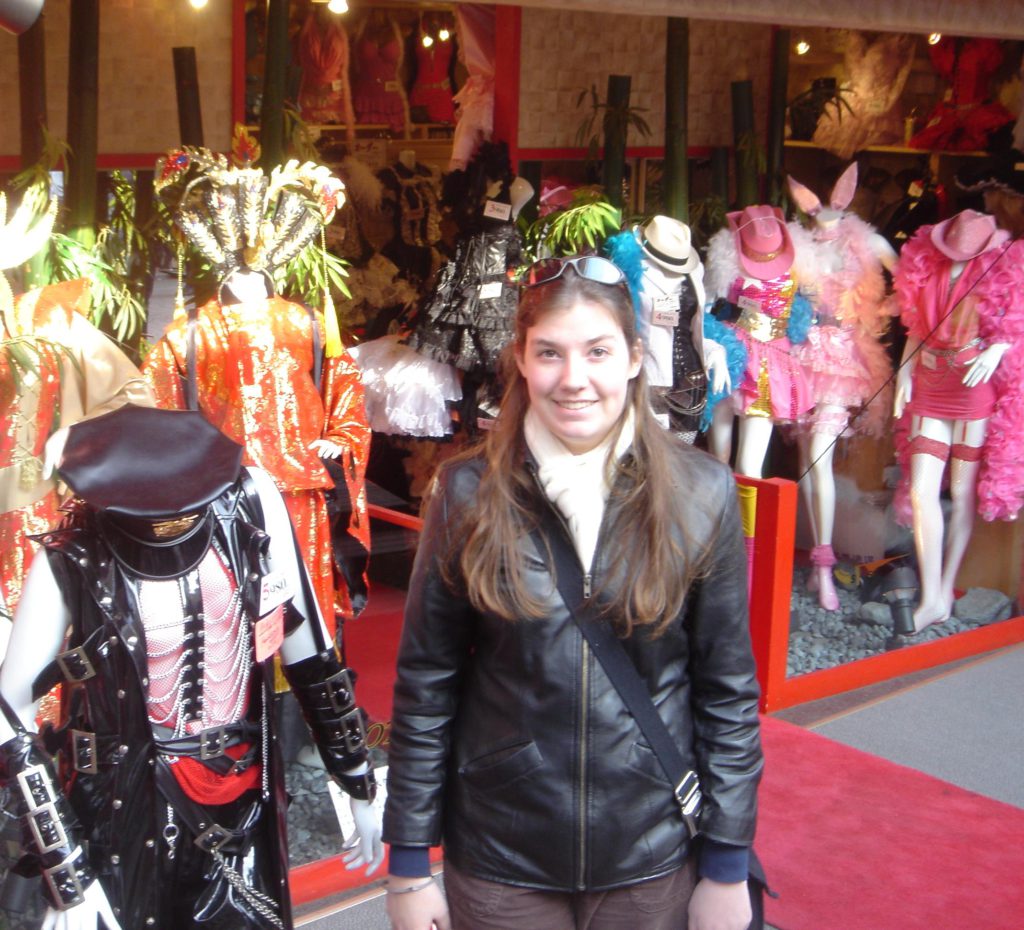
Back at Kiddy Land she bought a few more gifts for friends, and a plush radish (we didn’t have one of those). Then we headed back to the hotel to rest our feet and get ready for New Year’s Eve.
The hotel’s approach to housekeeping is interesting. A team of five housekeepers — men and women — descend upon the room and completely remake it in under ten minutes. This includes carefully wiping every edge that could possibly collect dust.
The hotel staff has also been leaving small gifts in our room: a box of candied chestnuts, mint chocolates shaped as leaves, a chestnut pie, an artisan-crafted flask of sake.
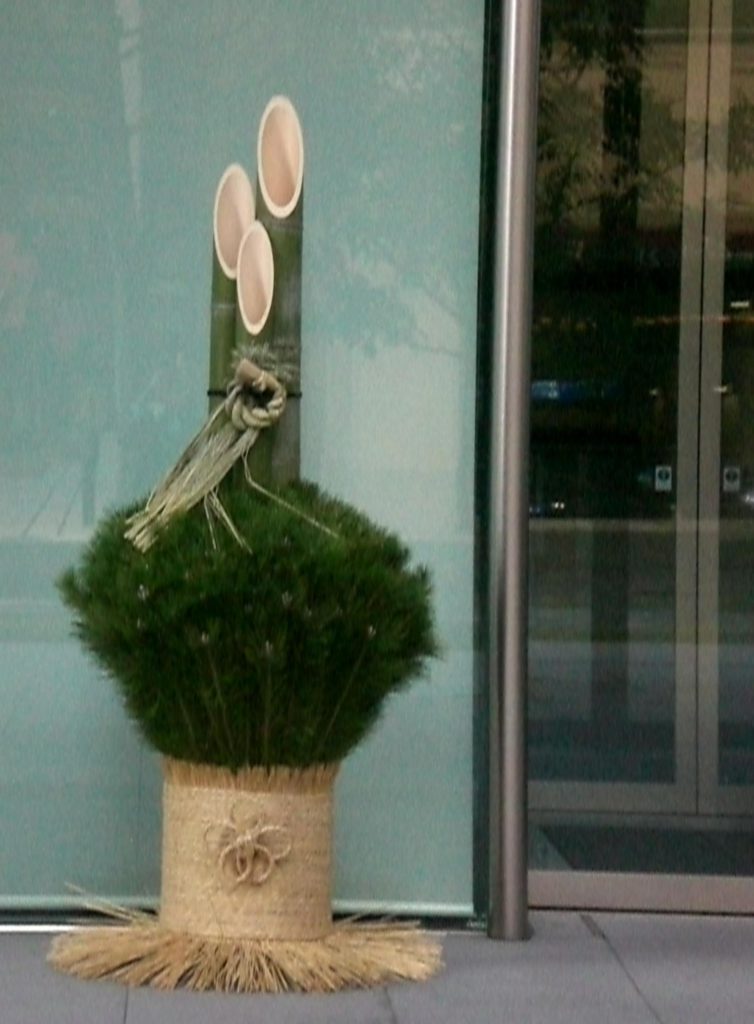
We took a twenty-minute taxi ride to our 8 pm dinner at Gonpachi. It was quite fun zipping through the narrow, winding streets of Tokyo at high speed in the light traffic. The taxi was equipped with a high resolution gps screen that appeared to display live street condition information.
Although there were quite a few locals dining there, Gonpachi seems to be oriented toward clueless tourists. When George Wacko Bush was in Tokyo he dined there, and if anybody is clueless, it’s him.
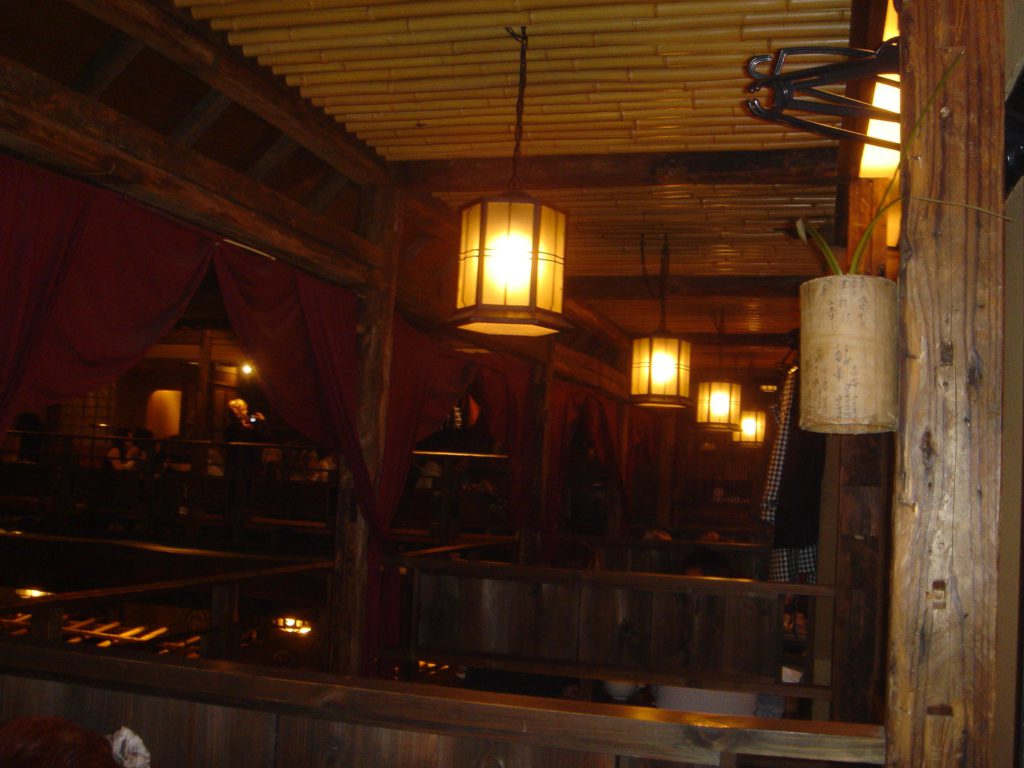
The restaurant is a two-story affair. We sat on the second floor, a mezzanine surrounding the food preparation area below. We removed our shoes and climbed into our booth which, like the rest of the restaurant, was constructed from very old wooden beams.
Down below, the restaurant was a lively space, filled with chefs grilling things on sticks, making tempura, and a wide variety of other traditional foods. Tapas style (it even said tapas on the menu), we tried a variety of things, and it was all tasty. Prices were very reasonable, less than $3 a skewer. The Louis Roederer Champagne was good, too, and a bargain at 8500 Yen.
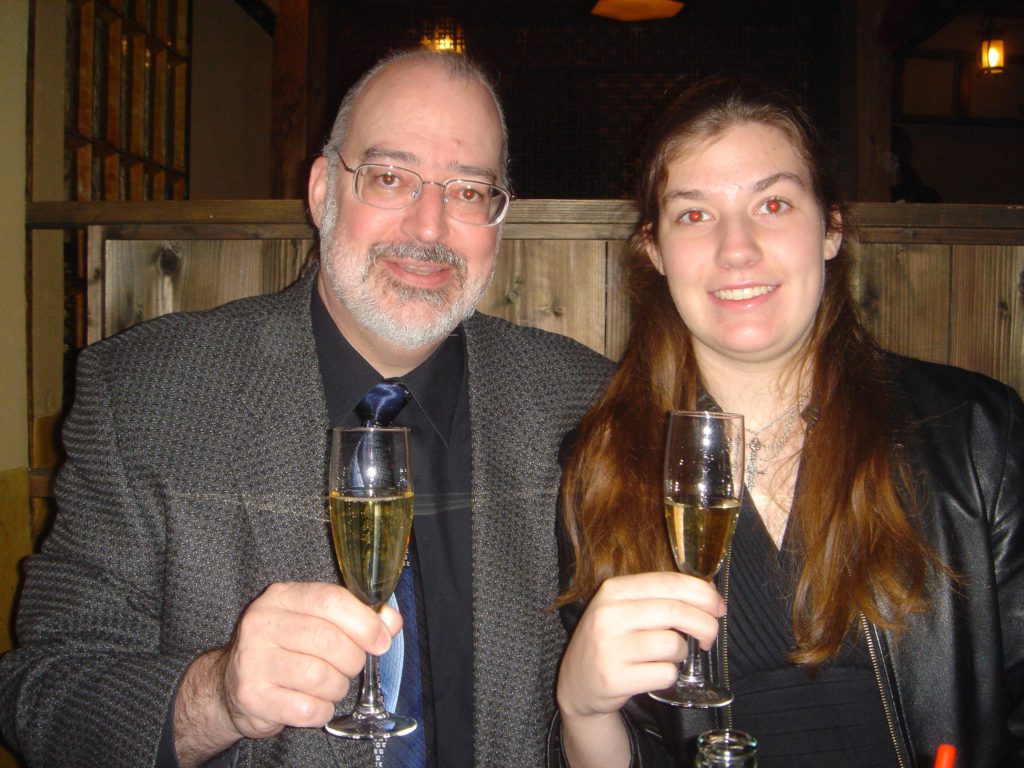
A line of cabs waited out front, so it was easy to get back to the hotel.
Dani watched the New Year arrive on our room’s high definition flat panel TV. The New Year’s countdown involves Japanese pop music, and banging a giant gong. It seemed a little strange to welcome the New Year, knowing the Times Square Ball won’t drop until tomorrow afternoon at 2 pm!
For the Japanese, New Year’s is a time for leaving the old year behind, and starting fresh, so we’ll say “Sayonara” to 2006.
Monday, January 1, 2007
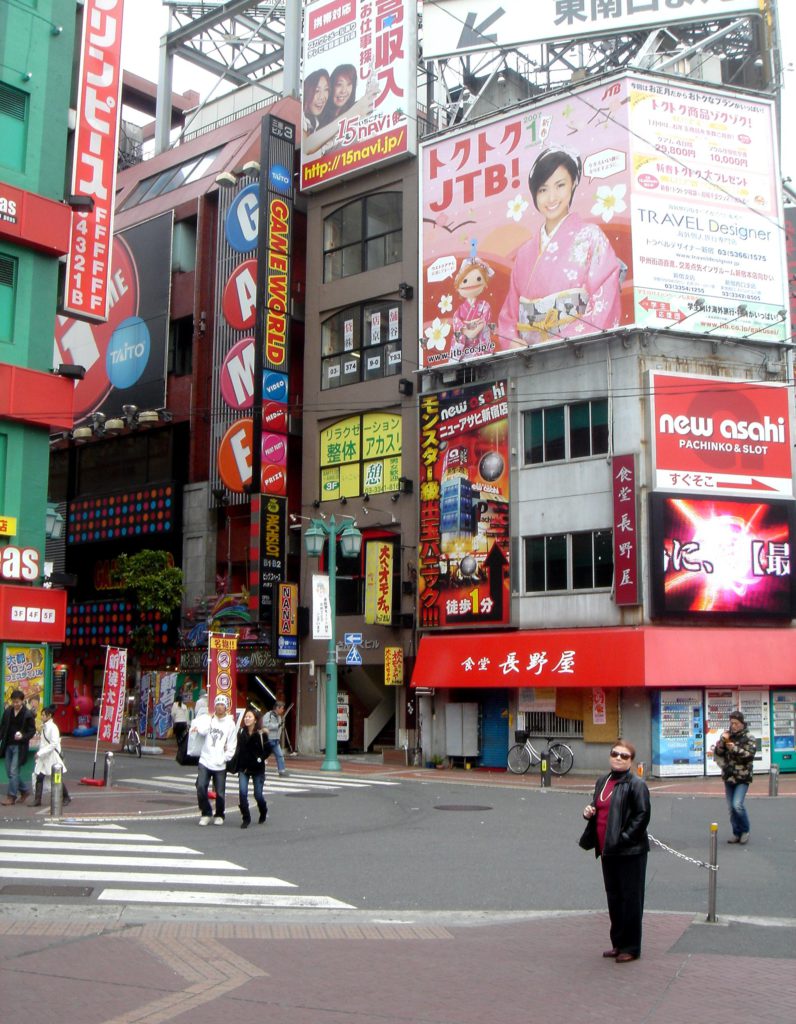
After a room service breakfast Linda and I set out to explore while Dani stayed in the room to do some writing. It continues cool, but the smog is encroaching, and our view of Mt. Fuji is history. We now realize how lucky we were.
Because of the holiday, the streets are almost deserted. This trip timing has worked out really well for us. Everything we’ve wanted to see or do has largely been available, but with one tenth the normal crowds.
We were expecting everything to be closed because of the holiday, but quite a few shops and many restaurants were open. We began by walking through the twisty little streets not far from the hotel. There were actually quite a few people in the electronic stores. It must be a madhouse on a normal day.
We walked through the train station to the east side, which is the true Shinjuku: a maze of shops, department stores, cinemas, love hotels (rented by the hour), restaurants, pachinko parlors and arcades. It goes on for about one square mile!
We wound our way through the streets for a couple of hours, looking for a restaurant with either an English menu or pictures of the food. Finally we selected a conveyor belt sushi restaurant. You sit at a counter and small plates of sushi travel past on a conveyor. You simply take what you want, and are charged by the number and color of plates in your pile at the end of the meal. No English required. A box of green powder proved to be tea (not wasabi, as we discovered the hard way) which we placed in mugs filled from the hot tap at each seat. The sushi was fresh and delicious, and ten plates of it came to only $15.
On the way back we walked past the Hilton and made a reservation for dinner at Twenty One, their French restaurant. It’s normally closed on Monday, but they are serving a set menu for the holiday. It seemed unpopular, and the Maitre d’ told us a reservation would be no problem, as the Japanese guests all wanted the traditional New Years menu served in the Japanese restaurant.
Dinner proved quite good, not exactly French cuisine, but certainly not Japanese either. Closer to what I’ve come to call new American cuisine: seared fois gras, braised short ribs, and so on. Prices were comparable to upscale prix fixe menus in the US.
As I headed to bed it was funny to realize that the Rose Parade won’t happen here until January 2nd.
Tuesday, January 2, 2007
Kyoto
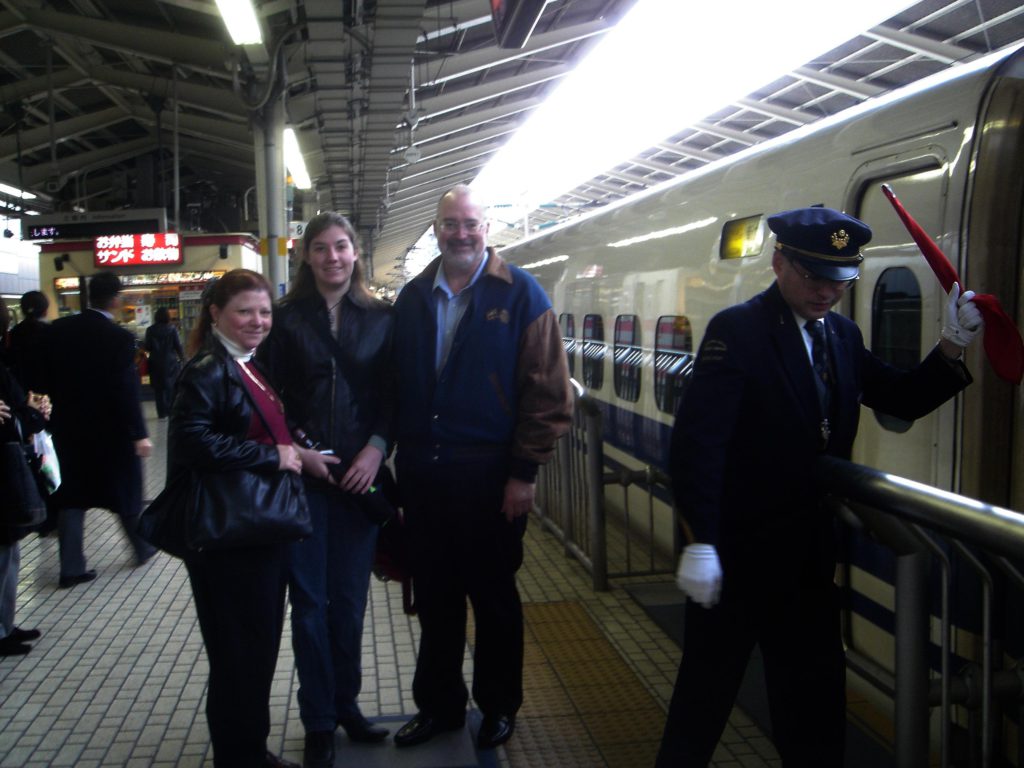
We met our guide, Ms. Junko Matsuda (Jun), in the hotel lobby at 8 am. Ms. Matsuda is a lovely Japanese woman who has lived in Hawaii for a year and Kansas for five years. Her business, Jun’s Tokyo Discovery Tours, specializes in personal guided tours of Tokyo, but she also takes clients to other cities. Although she goes to Kyoto several times a year, this is the first time she has gone during the New Year’s, when many (many) Japanese journey there to visit the shrines.
We walked to Shinjuku Station and took the express train to Tokyo Station, where we transferred to the Shinkansen bullet train. This high speed train glides on welded rails at 276 km/hr, making the journey to Kyoto in two and a half hours. We had reserved seats in the ‘green’ section, which were very much like first class airline seats, but with one additional trick. Any pair of seats can be rotated 180 degrees to form a four-person grouping. Perfect.
Traveling through the low mountains that divide the east side of the main island of Japan from the west we passed through agricultural areas and saw snow- dusted fields of rice. Lines of snow hung on the tile roofs of the houses.
Arriving in Kyoto’s modern railway station we found the city crowded with Japanese visitors. We stood in a long but fast moving line, waiting for a taxi. There was a slight drizzle as we waited, but it stopped during the cab ride and didn’t return.
Each of our four taxi drivers during the day was obviously quite proud of their beautiful and historic city, and enthusiastically provided information along the way. Jun translated for us, and we enjoyed the driving almost as much as the places we visited.
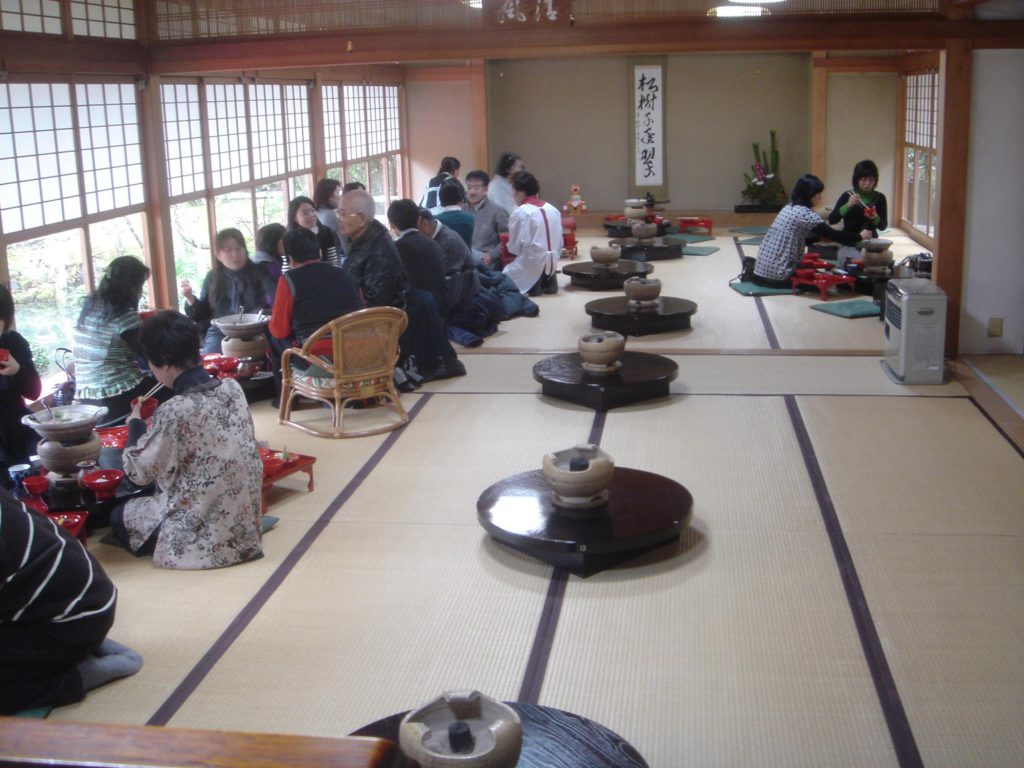
Our first stop was at a Zen rock garden. Before visiting the garden we had lunch in a tatami room. This was our most authentic traditional Japanese experience of the trip, and I wondered if it was for tourists. I suppose the answer is both yes and no. Many Japanese use Western style furniture in their homes, so when visiting Kyoto they enjoy the traditional ways. But we saw almost no other westerners during our entire day, so this is clearly something they like to do.
Before entering the tatami room we placed our shoes in storage cubbys in the entryway.
We sat on woven tatami mats. Their standard size, one by two meters, is used to designate room size. For example, a bedroom might be a six tatami room.
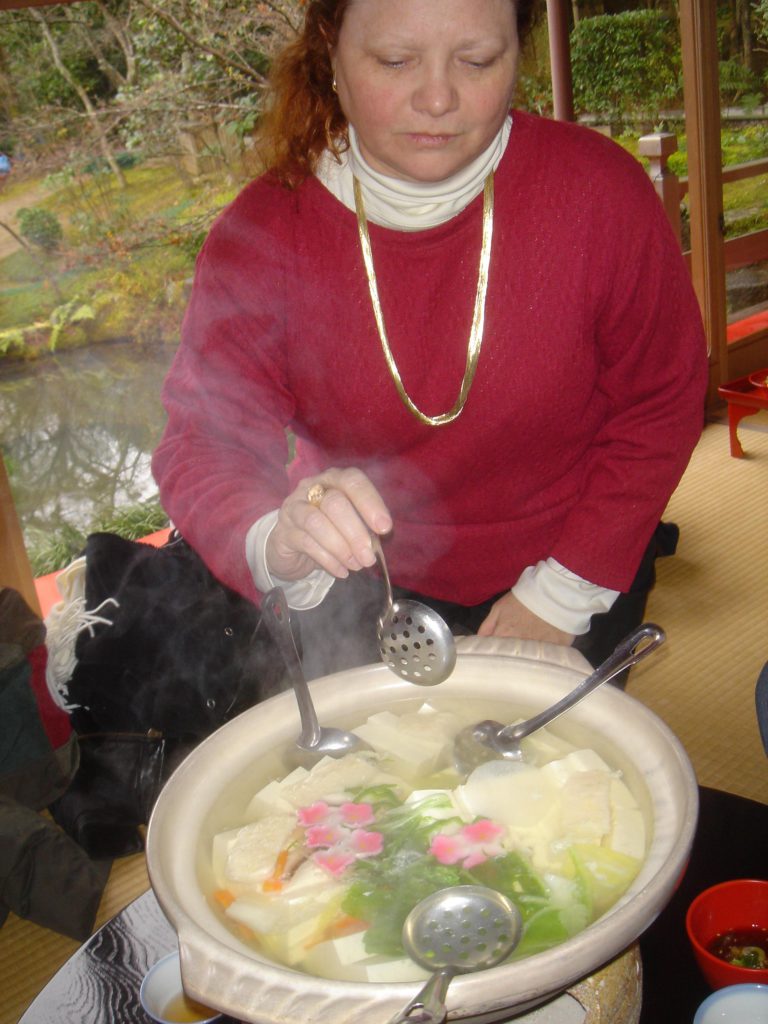
In the center of the mat was a burner used to heat a large bowl filled with tofu cubes and vegetables. In addition, we were each served a small tray/table with a variety of tofu preparations, Japanese pickles and other tasty items. I had never had very good tofu in the States, so I was somewhat skeptical, but everything was tasty, and we all enjoyed the experience very much.
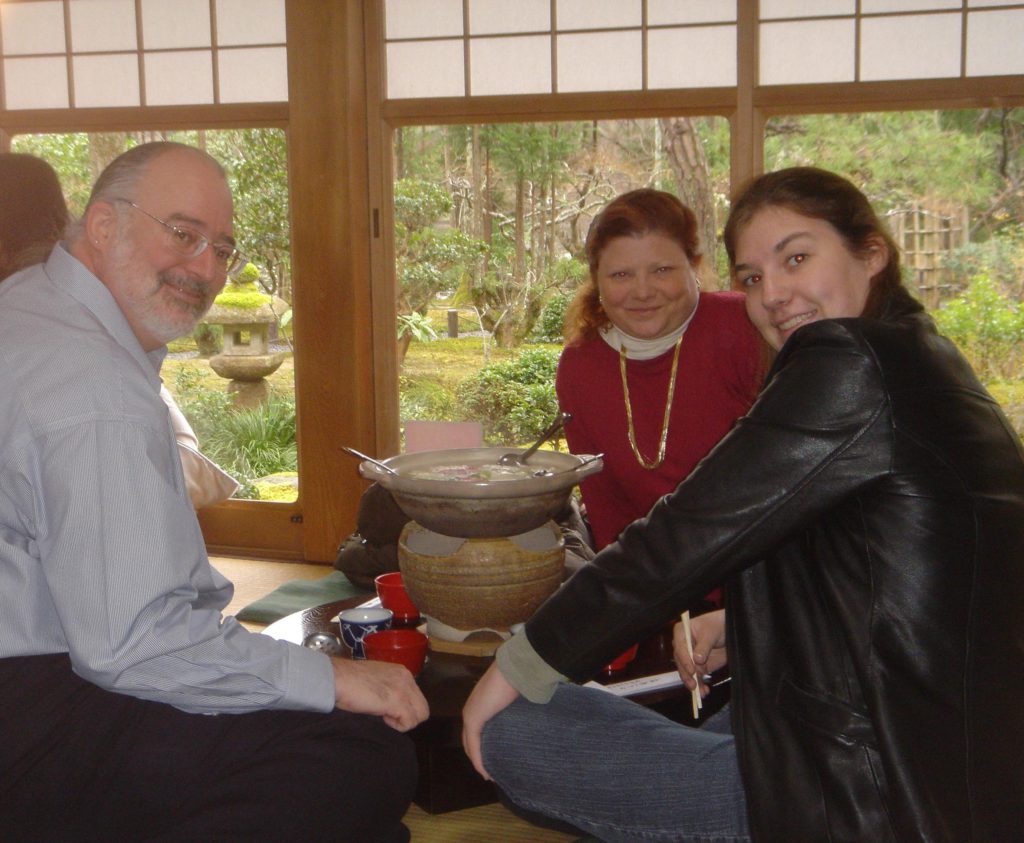
After lunch we strolled through the peaceful landscape of woods, skirting mirror-like ponds. A mossy carpet covered the ground beneath the trees.
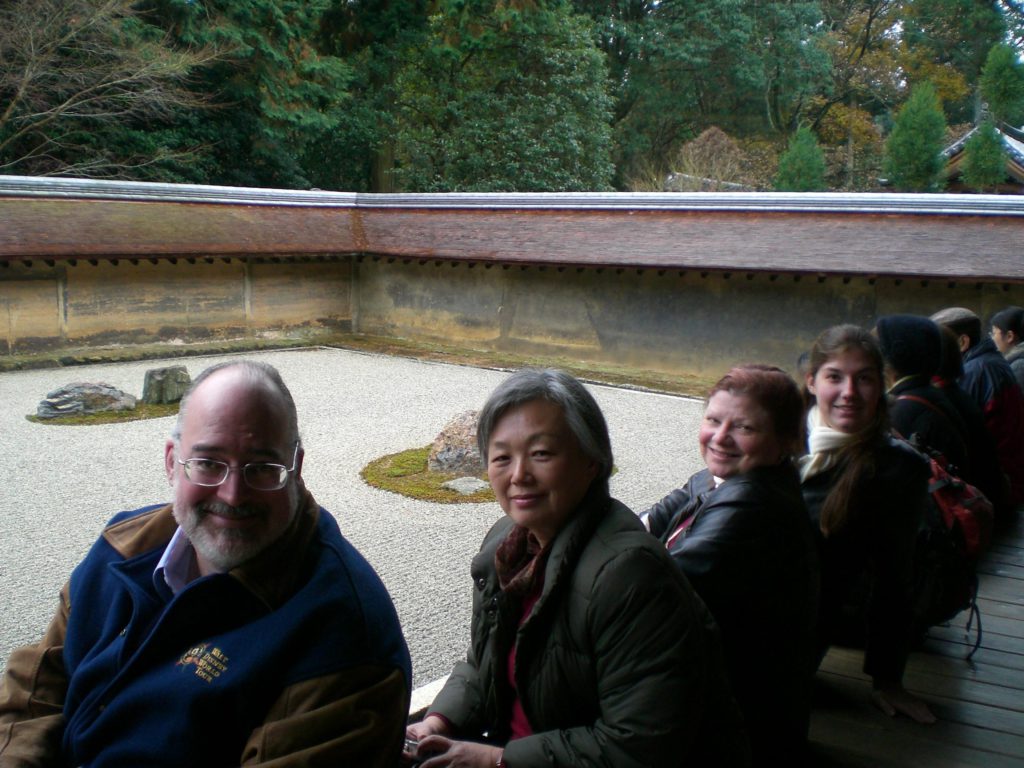
At the Zen garden we again removed our shoes and donned slippers. Benches line one side, allowing visitors to sit and contemplate the fifteen stones surrounded by smooth-raked gravel. It might seem silly to a generation raised on video games, but I found it quite peaceful (except for the large crowd coming and going).
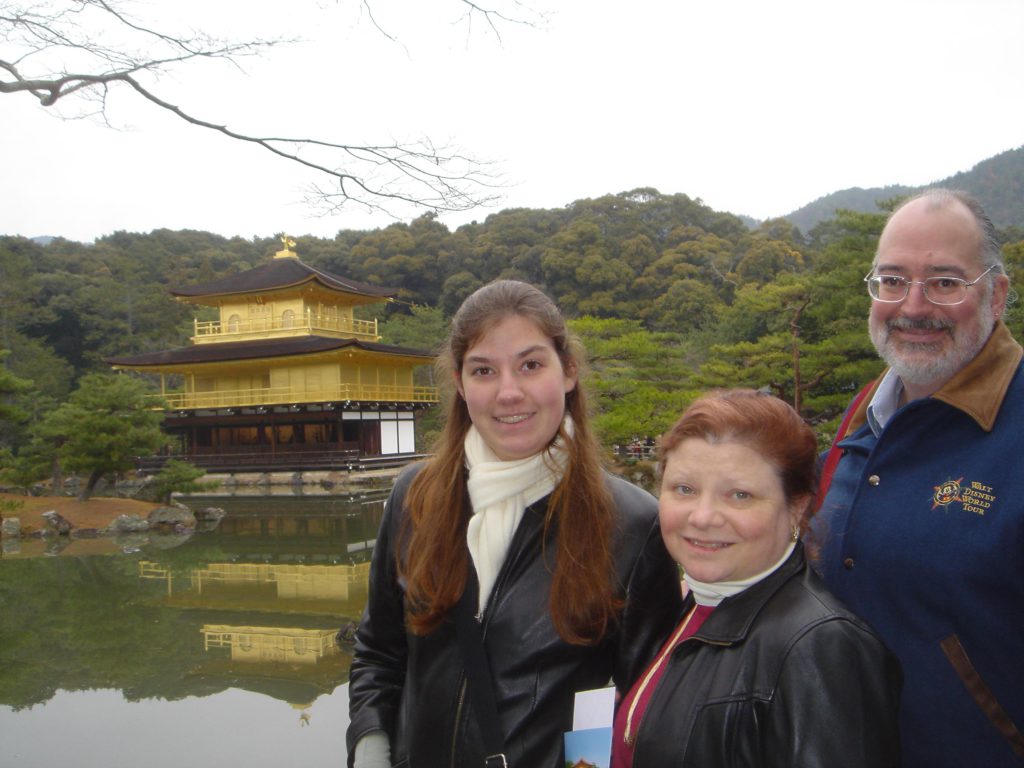
Our next stop was at the Golden Temple. This Buddhist shrine is a popular spot to visit when seeking luck for the new year. It was burnt by an obsessed monk in the 1950s, but has been reconstructed exactly as it was. Although not allowed to enter the temple, hundreds of pilgrims were making a procession around the site, and we joined the flow of traffic.
Visitors fanned incense from a brazier onto themselves for its good luck properties.
Along the path many small booths sold a variety of items. It is a fad in Japan to add “accessories” to cell phones. These small charms or souvenirs dangle in clumps from almost every teenage girl’s phone. They might be a Hello Kitty, a Disney character, or a traffic safety charm.
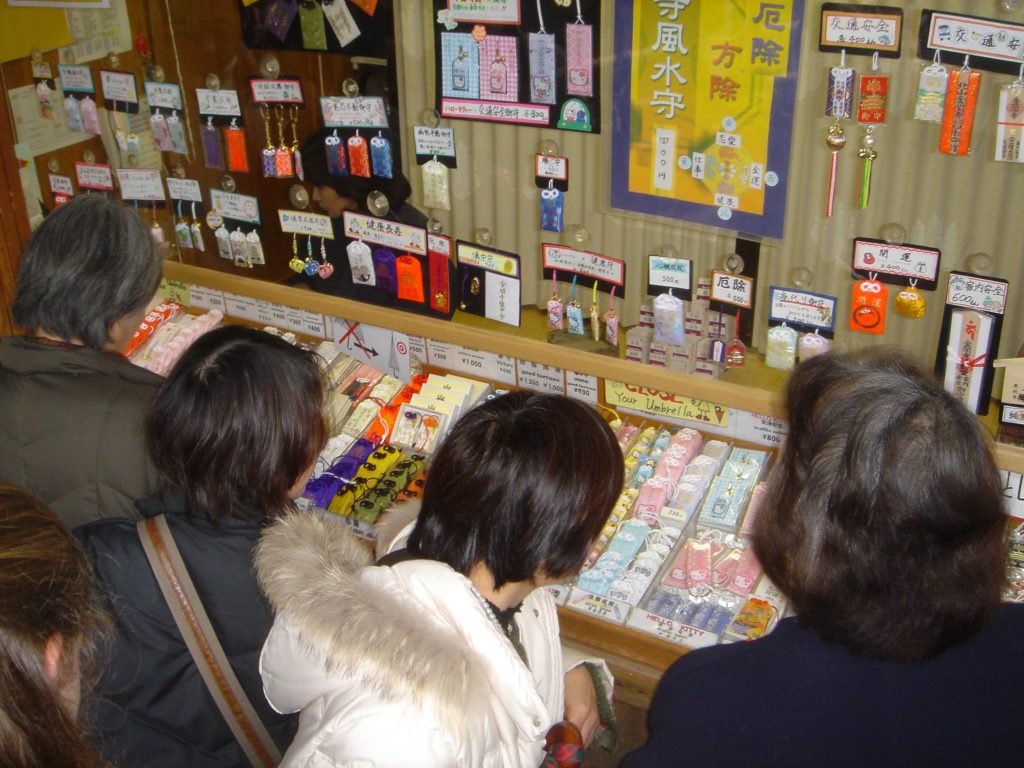
Dani bought one for scholastics, just to be on the safe side.
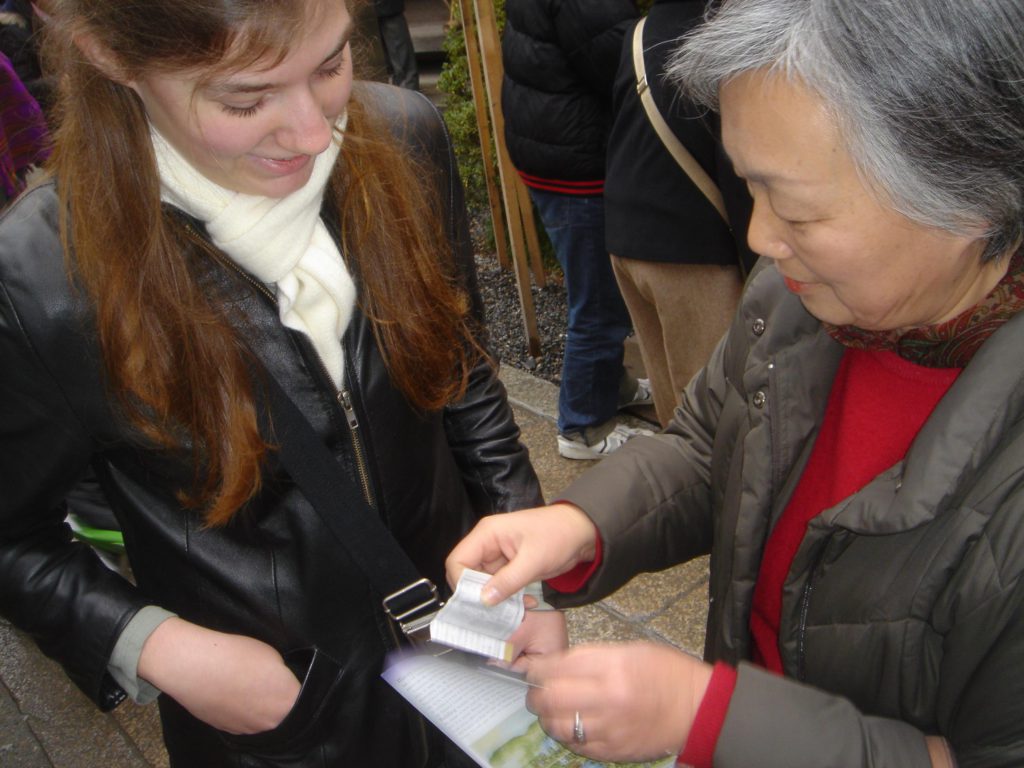
Fortunes were also for sale, printed on small scrolls. Not all are good. Jun helped Dani read hers, which was favorable.
Linda’s advised her not to volunteer for anything!
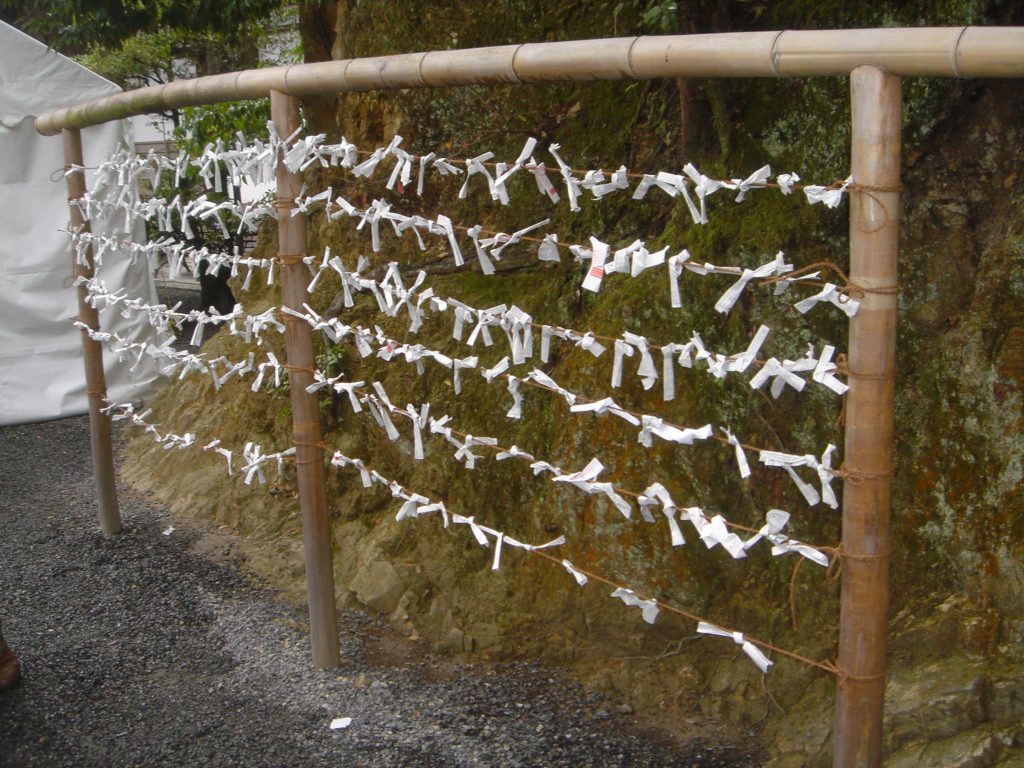
Another taxi drive found the streets of Kyoto approaching gridlock. We wove our way through back streets to Gion, the neighborhood described in Memoirs of a Geisha.
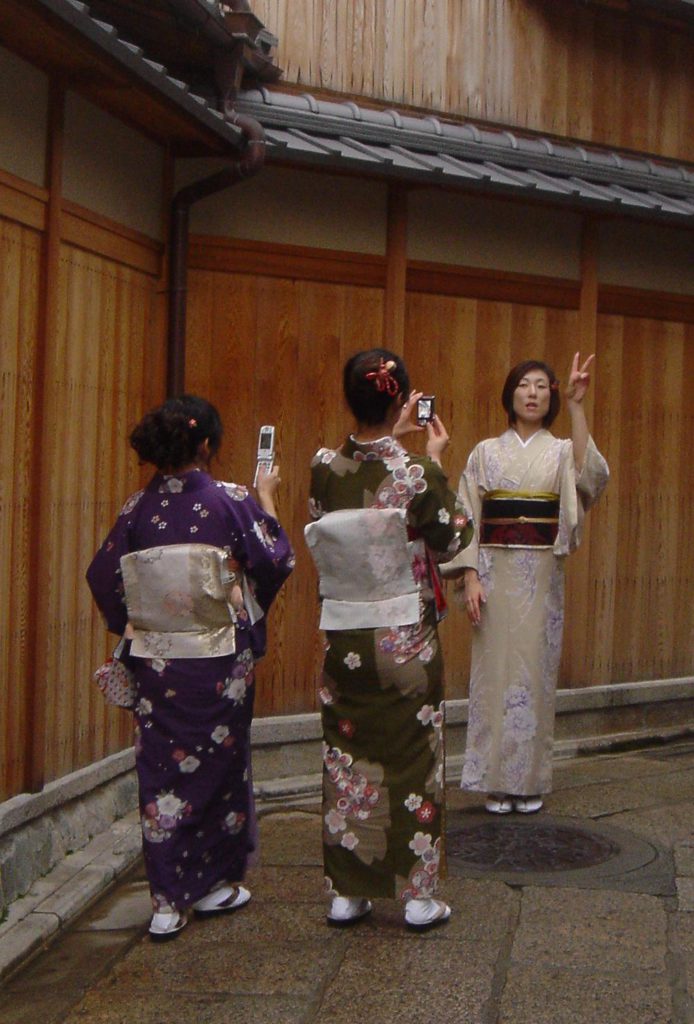
There are only about 100 geisha left in Kyoto. They entertain at private parties, at a cost of about $3000 an evening. Although we saw no geisha, many, many of the women were dressed in beautiful kimono to celebrate the new year.
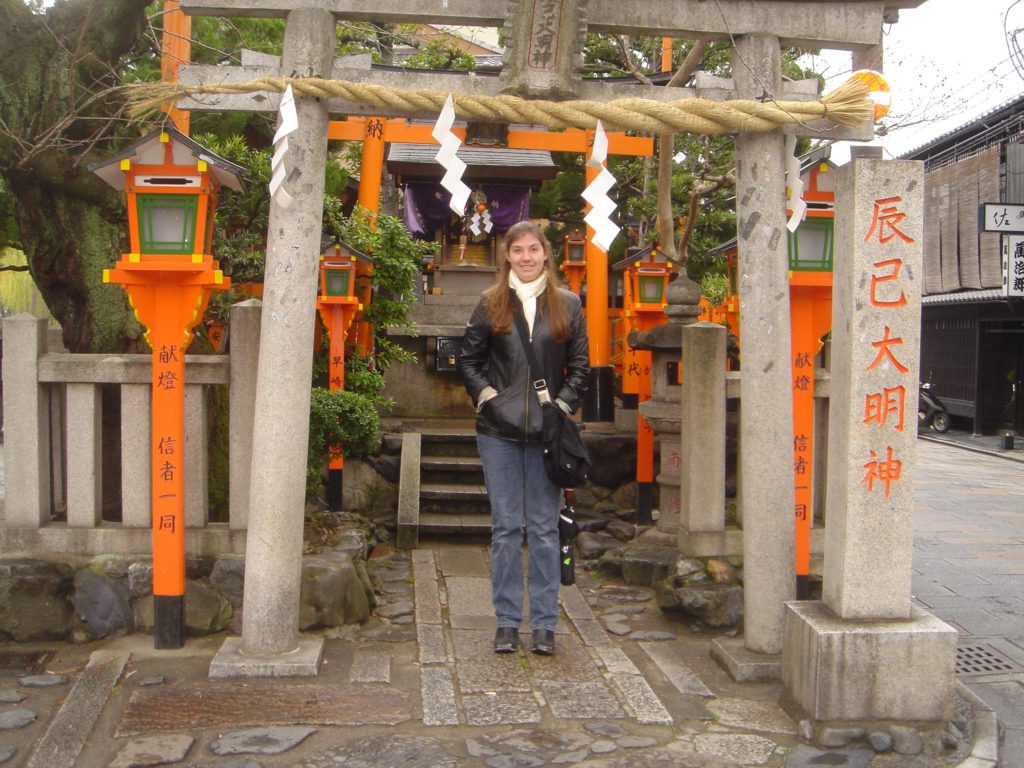
Nearby we posed in front of a famous pagoda, and walked up a winding street lined with shops, many of them making and selling beautiful — but expensive — ceramics. The area is known for its art and literature, and this was evident in the beauty of both merchandise and neighborhood. Vendors stalls also sold homemade food items, and Jun bought us each a freshly made rice cracker wrapped in seaweed. Delicious, and very different than the bit sized rice crackers we are used to; this was more like a rice cake.
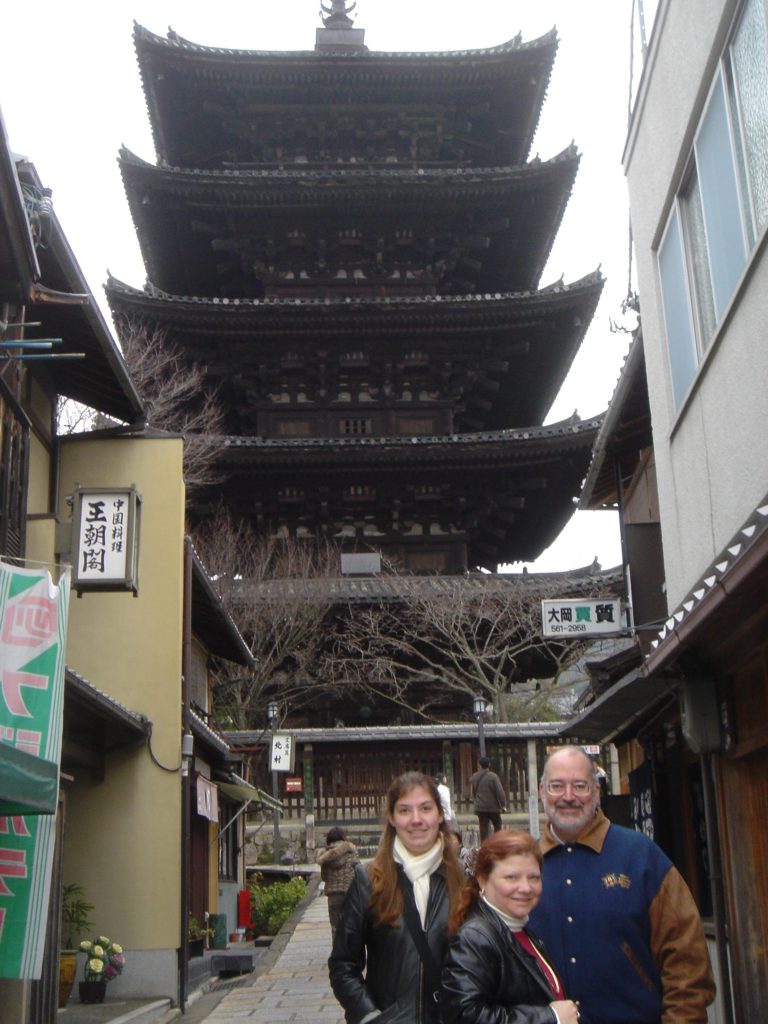
A final taxi ride of the day returned us to the station where we boarded our Shinkansen for Tokyo. Jun had purchased some origami paper at the station, and spent the train ride teaching Dani how to make cranes. It is a tradition to make 1000 cranes for various occasions, such as a sick loved one. Dani has about 997 to go.
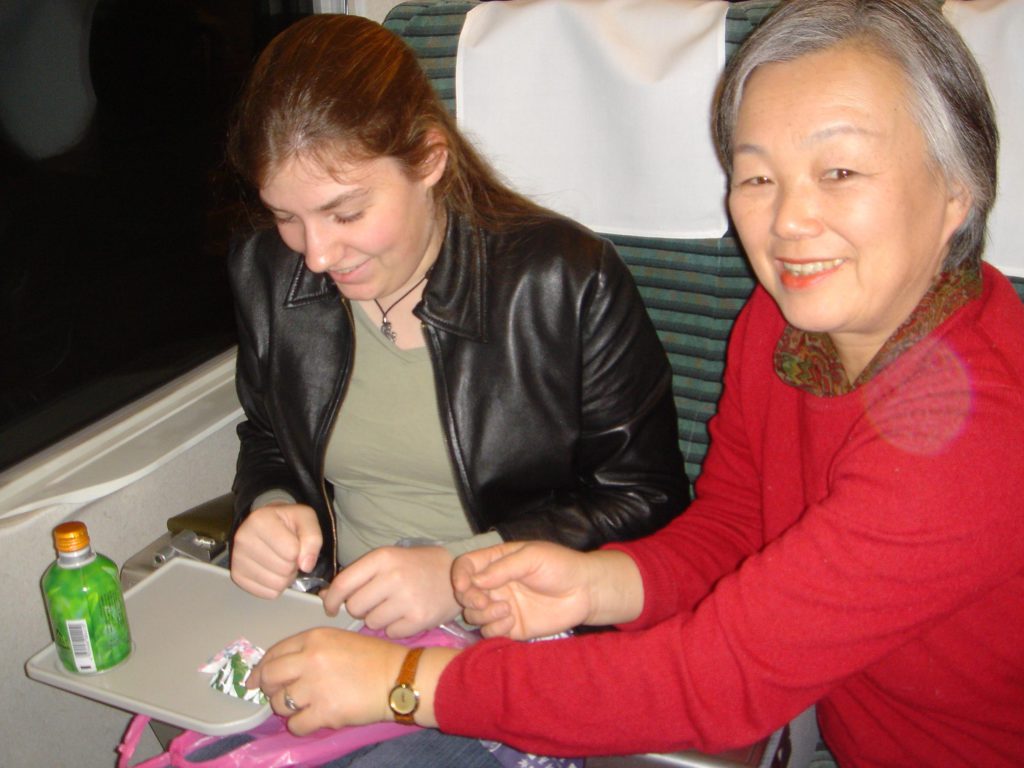
We could have easily made the journey to Kyoto on our own, but without Jun’s help we would have seen very little and understood less. We are very indebted to her for her guidance and especially her friendly and fun attitude.
Wednesday, January 3, 2007
Tokyo DisneySea
We decided to spend our final day in Japan visiting Tokyo DisneySea, a project we’ve heard a lot about, but didn’t really know much about. I always enjoy visiting places where our equipment is in use, trying to guess what is backstage. And indeed, we wouldn’t be going backstage, as none of Linda’s co-workers had been available to let us in, so we’d be going as paying guests.
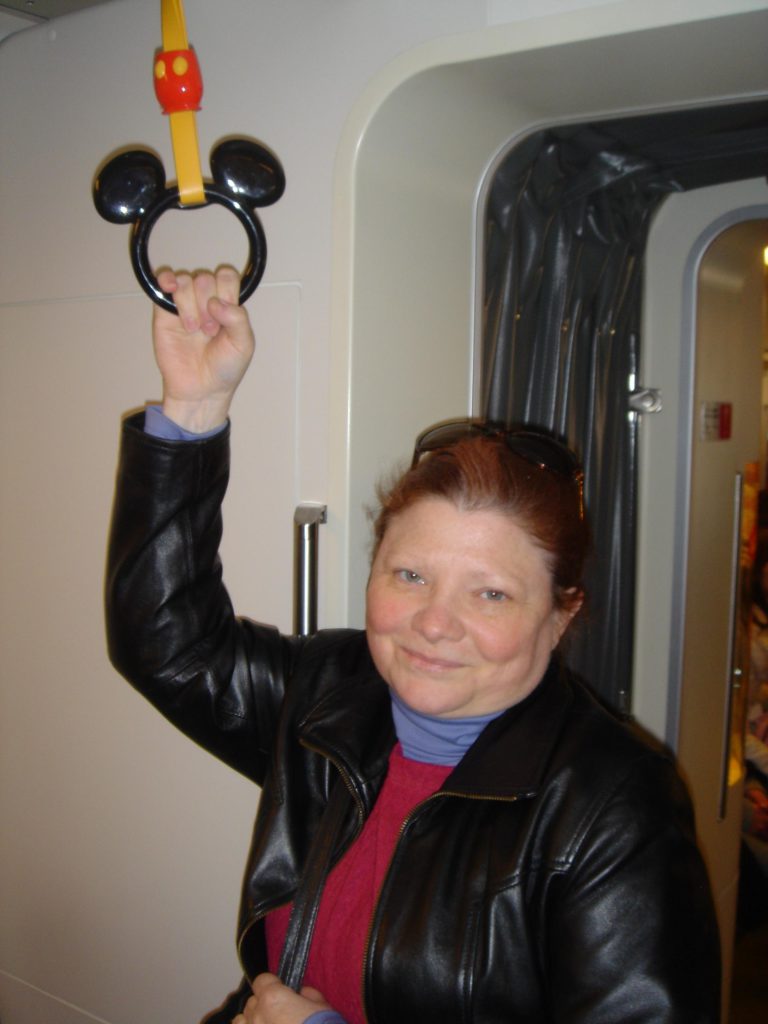
Feeling fairly comfortable with the Tokyo rail lines, particularly with some new insights from Jun, we took the Chuo express train from Shinjuku to Tokyo station and then transferred (after what seemed like a mile walk) to the Keiyo line for the trip to Maihama Station. The total journey took less than an hour, and was very easy, even with almost no English signage. I wouldn’t have wanted to try it a few days ago, though!
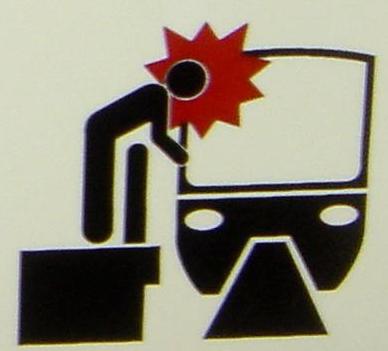
At Maihama you take the Disney monorail to one of two theme parks or the resort complex. The monorail seems a bit less like a ride when you’ve just taken two similar systems to get to the park!
We were afraid Disney would be very crowded because of the holiday, but the parking lot was less than half full. That’s not to say there weren’t long lines — nearly every attraction involved a wait of 30 to 90 minutes. But the Japanese don’t seem to mind queues. There was even about a 30 minute queue to play redemption games!
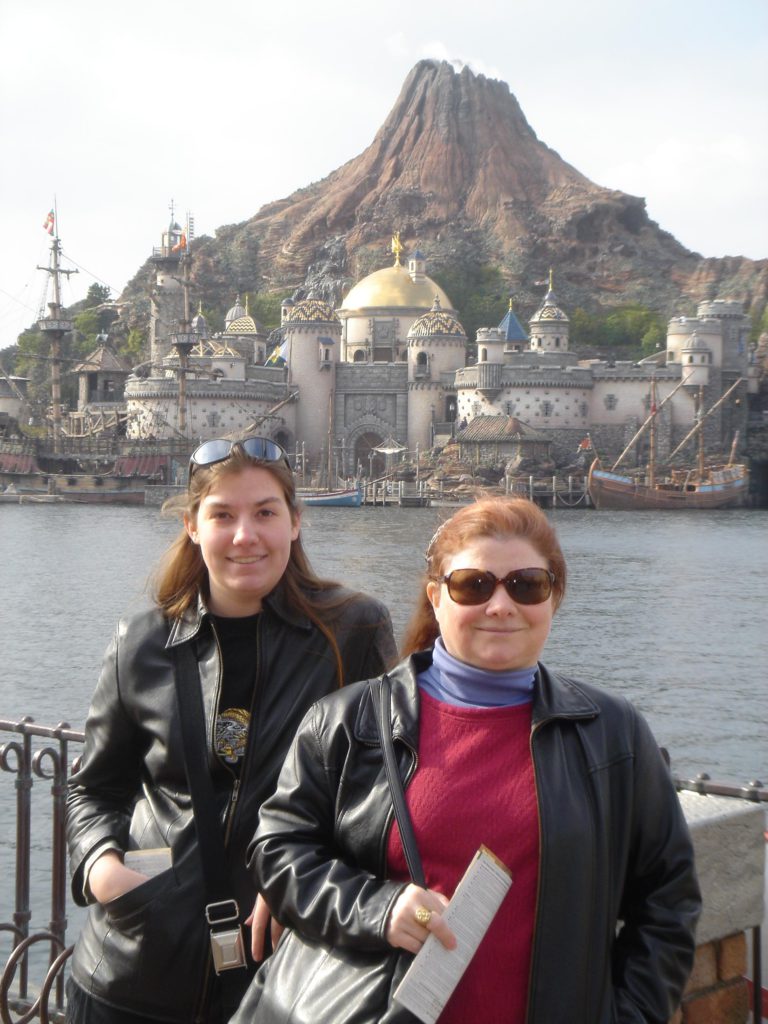
Tokyo DisneySea is (as of this writing) the world’s most expensive theme park, and it shows. With a budget of over $2 billion, every detail is simply perfection. It’s hard to believe this park was done by the same people and at the same time as the low-budget Disney’s California Adventure.
We began our visit with lunch in the steamer that is docked in the American Waterfront section, dining on those American favorites grilled prawn sandwich, bouillabaisse and roast beef on graham. Those crazy Americans!
Then we ventured over to the park’s central feature, a giant volcano. A castle at the base housed interactive science exhibits themed to the era of the alchemists. Rooms were devoted to the Coriolis force, the rotation of planets, lenses, and a working copy of Leonardo’s flying machine. Really neat!
Inside the volcano’s caldera is the best themed area ever. A lagoon bubbles and froths, and occasionally holes open and water simply disappears into the abyss. A 20,000 Leagues sub is docked at one side. Overhead an earth boring machine hangs poised to drill into the mountain side. Steam oozes from crevices in the rock, and strange metallic noises echo around the rock faces. Everywhere there are strange, hand-wrought metal structures that look like something out of the computer game Myst.
Descending into a dark tunnel we entered a heavily-themed queue for Journey to the Center of the Earth. The wait was about an hour, but there was lots to look at. The ride vehicles are large earth borers that travel through a number of fanciful scenes before encountering a giant, highly articulated creature. The ride then accelerates rapidly, bursting out of the rim of the caldera for a moment before dropping back down into the caverns and unload. Very well done.
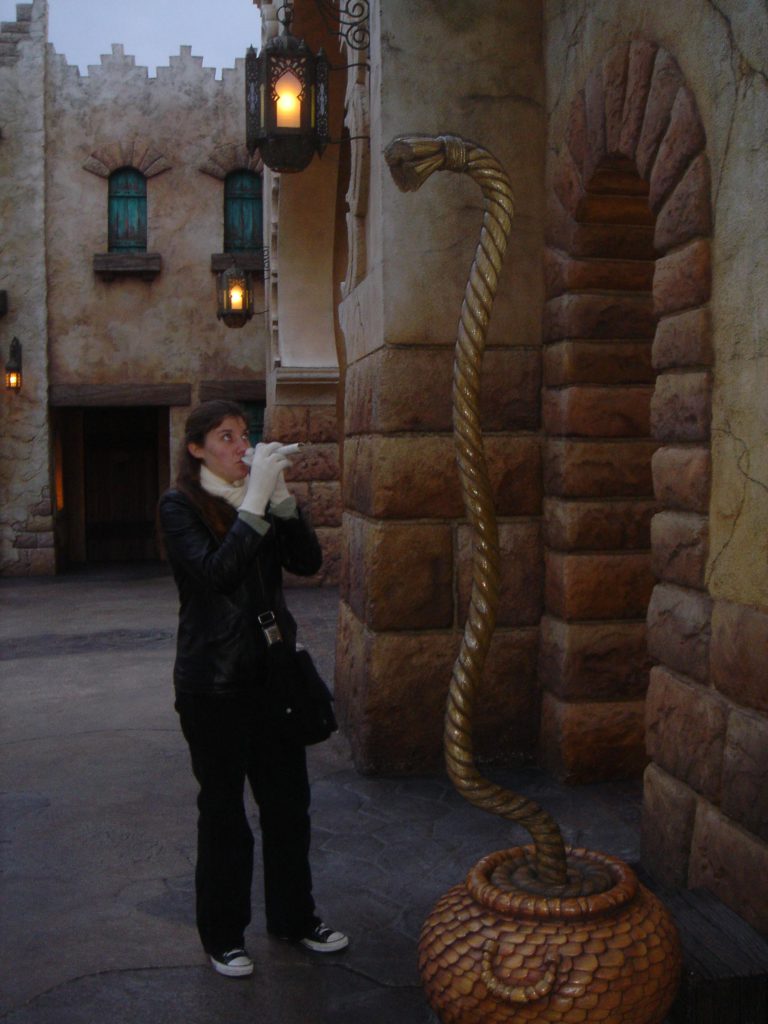
Next we wandered past the Mayan pyramid that houses Indiana Jones, and then spent some time shopping in the Arabian marketplace.
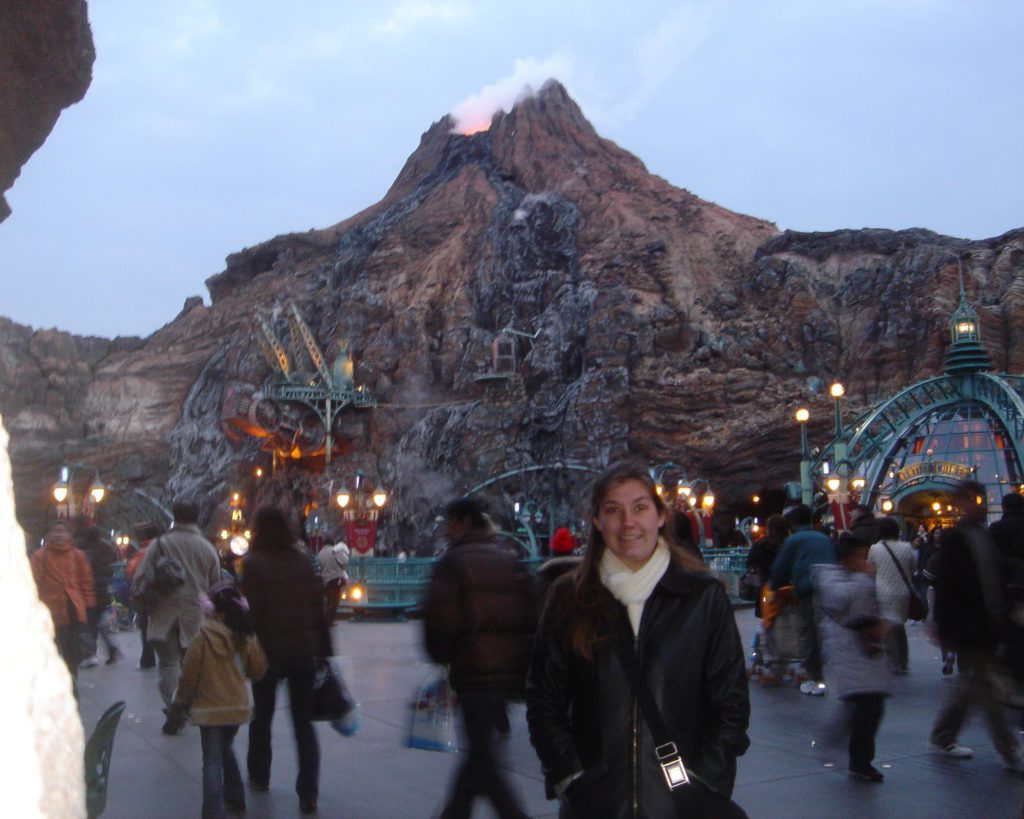
When our Fast Pass time came up, we returned to the caldera, now even neater with evening lighting, for 20,000 Leagues Under the Sea. For this ride you enter a diving bell vehicle that seats two people at each of three large domed windows. Bubbles swirl as you submerge. (Actually the bubbles are trapped in the domed windows, and the ride remains dry, a real maintenance saver. It’s a superb illusion. )You encounter various undersea life and discover a lost city populated by strange creatures before “resurfacing. “
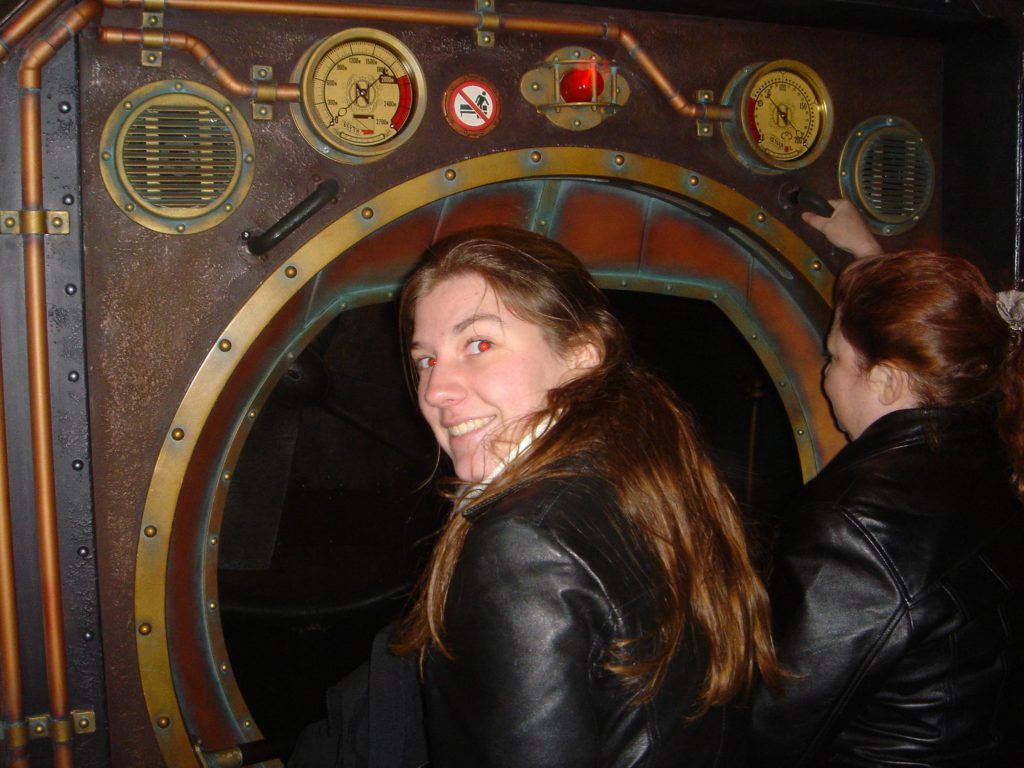
By 6 pm the cold air off of Tokyo bay was pretty chilly, but a new crowd of visitors was just arriving to take advantage of the after 6 pm rates. It was time for us to retrace our steps by monorail and train, back to the hotel. We rested for an hour, then headed upstairs to the New York Grill for our Tokyo farewell dinner. The restaurant is a stylish mix of metal and glass, with two-story-high glass walls on all sides. A jazz combo played old standards in the lounge on one side, their backdrop the solid glass wall and twinkling vista. The multi-course meal was tasty (and pricey), and the 360 degree view of Tokyo’s lights superb.
Thursday, January 4, 2007
Sitting by the window finishing this journal, I’m contemplating what a great trip this has been. We’ve crammed a lot into our six days in Tokyo. And as I look out at the city — just now gearing back up to its normal bustling level — I realize what a perfect time of year this was to come. We had a chance to explore without crowds, and the holiday didn’t interfere at all.
I really like Tokyo and its people, and definitely want to return for another visit.